
WHAT'S NEW IN ANCIENT HISTORY
BY ERNEST GILL
Archaeology Headlines
Have Moved To:
ANTINOUS THE GAY GOD BLOG
All Earlier Headlines Back to 2008 Are Listed Below
JANUARY 16th, 2012

WHAT'S NEW IN ANCIENT HISTORY
BY ERNEST GILL
All Earlier Headlines Back to 2008 Are Listed Below
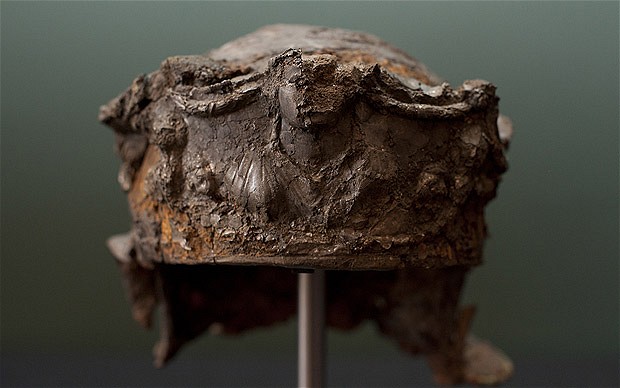
This amazing 2,000-year-old Roman helmet has been lovingly restored by experts at the British Museum who say that it could turn the history of Roman rule in Britain on its head, so to speak.
When archaeologists unearthed it in 2001, at a spot in Hallaton, England, where hundreds of Roman and Iron Age coins had been found the year before, they initially joked they had found a rusty bucket.
But the discovery turned out to be one of the most significant Roman finds ever made in Britain.
Lifted out of the field in a mud block and pieced together from hundreds of fragments like the world's most expensive and delicate 3-D jigsaw puzzle, the helmet was painstakingly restored before finally being unveiled at a news conference at the British Museum.
It is the only Roman helmet found in Britain with the majority of the silver-gilt plating surviving, and one of only a handful ever discovered. It is also among the oldest Roman helmets ever found in Britain.
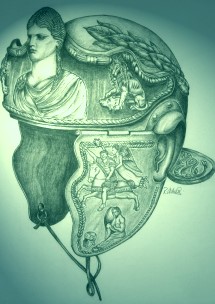
But the most extraordinary thing of all is the fact that the helmet was discovered at the burial site of a British tribal chieftain. The experts believe it could transform our understanding of the Roman conquest of Britannia.
"How did it get there? The simple answer is that it was worn on the head of a Briton," said Dr. J.D. Hill, head of research at the British Museum.
"The old view is 'Romans bad, Britons good'. This discovery muddies the waters. You can't overestimate the shock and surprise when it was first found," he added. "This is a major discovery that says we have to rethink the relationship between the Britons and the Romans. It is an iconic object and every book on Roman history from now on will have this in it."
The treasure, known as the Hallaton Helmet after the area where it was found, dates to around the time of the Roman invasion in 43 AD. A Roman goddess flanked by lions adorns the brow, while the cheek pieces feature a Roman emperor trampling a barbarian beneath his horse's hooves.
In its day, the helmet would have been a stunning sight — the ironwork plated with silver and details picked out in shimmering gold.
The intriguing mystery of how the helmet came to be buried in a field near Hallaton is one which has baffled experts since its discovery. Historians beileve the site on which it was found dates between 100 BC and 50 AD and may have been a hilltop shrine created by the Iron Age Corieltavi tribe, who lived in the area at the time of the Roman conquest in 43 AD.
Thousands of coins, an amazing silver bowl, pig bones and the remains of a dog buried to "guard" the treasure all point toward the hoard being part of an ancient ritual.
But how such a high-status Roman helmet came into the possession of a local tribe remains a mystery. Helen Sharp, project manager of the Hallaton Treasure, said the find was evidence that people living in this area had some sort of relationship with the Romans, if you look at it as a diplomatic gift. But it could also have been a spoil of war, taken during a raid on a Roman camp or in battle, said Sharp.
What is known is that the helmet was of the highest quality and would have been specially commissioned by a high-ranking officer.
It is difficult to put a price on the helmet, but in 2010 a bronze Roman helmet with face mask was sold for $3 million at Christie's.
Dr. Hill said: "This one may not look like much by comparison but it is far, far more significant a find. Before it was restored, it was a lump of rust in a block of soil. When I see it now, my jaw drops."
Although the British Museum carried out the restoration work, the helmet will remain close to home. It will be displayed permanently at Harborough Museum in Leicestershire starting from January 28 alongside other finds from the site.
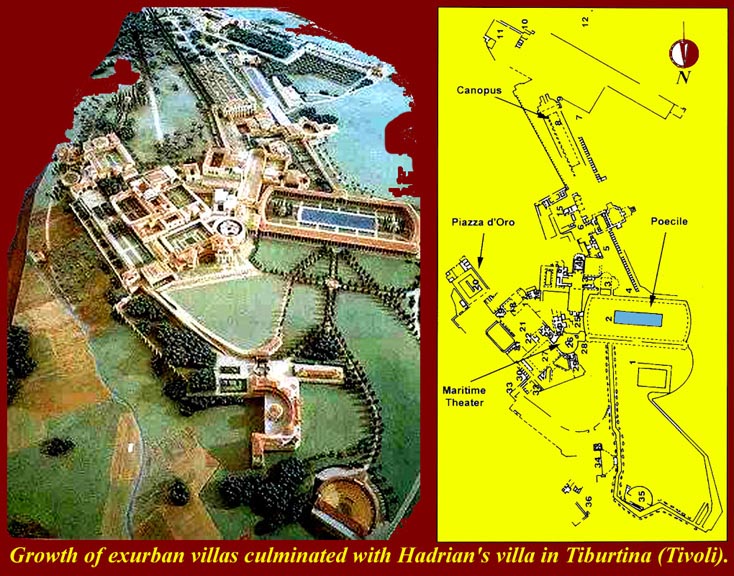
When he decided to build his palace in the fields outside Rome in the 2nd Century AD, the Emperor Hadrian wanted to escape the sounds and the smells of the capital.
Little did he imagine that 18 centuries later the stench of the city would follow him there thanks to plans to build an emergency garbage dump near the villa, as Rome runs out of space to bury its trash.
But now, another Roman noble has stepped in to defend Hadrian's villa near Tivoli from the garbage trucks, which are expected in the new year. Prince Urbano Barberini, an actor, farmer and descendant of a 17th Century pope, is mustering local farmers for a fightback against a scheme he claims will ruin the UNESCO-listed ruins.
"This is like dumping rubbish next to the pyramids — what if tourists have to time their visits according to which way the wind is blowing?" said Barberini, who produces olive oil locally. "And should people attending the concerts held at the ruins bring gas masks?"
The decision to dump rubbish in an old quarry near the villa, after Rome's main garbage dump at Malagrotta was filled to capacity, involved using emergency powers to overrule bans on developing the virgin countryside.
"There will be no going back on this, there can be no hesitation," said Renata Polverini, the governor of the region of Lazio.
A 250-acre complex of 30 buildings including palaces, baths, a theatre, temples and libraries built in Greek and Egyptian styles, Hadrian's villa centers around a small house sitting in the middle of a pool, accessed only by drawbridges, where the emperor could seek refuge from his court.
"You can't bury 2,000 years of history under tons of rubbish," wrote actor and campaigner Franca Valeri in a full-page appeal to Italian president Giorgio Napolitano taken out in Italian daily Corriere della Sera.
Barberini warned that a Roman era underground aquaduct which still carries water into Rome 25 kms away, is dug into the porous tufo under the site of the proposed dump and risks being polluted.
"A small tributary of a river that runs into the capital is also 30 meters from the site," he added. "It floods regularly, and we risk rubbish floating straight back to Rome."
A descendant of Pope Urban VIII, who commissioned works in Rome by Gian Lorenzo Bernini, Barberini owns a castle in the nearby picture postcard hamlet of San Vittorino. But he denied the campaign was a case of not-in-my-castle's-back yard.
"My visibility is useful, but this is really about local farmers who were all told to go organic and now will have nothing. We are fighting tanks with arrows, but this will be a battle to the end."
Local campaigners have been joined by Italian environmental group Legambiente, which has attacked the governor of the region of Lazio, which covers Rome, for opening new dumps instead of promoting recycling in Rome — with 80 per cent of the city's rubbish, it stated, still ending up in dumps.
The regional authority is also planning to unload tons of garbage in quarries next to the small town of Riano north of Rome, where locals have blocked railway lines in protest.
"We are heading towards a garbage crisis like Naples'," said Barberini. "Why couldn't they use their emergency powers to push recycling? The region once promoted the area around Hadrian's villa as a tourist destination, recommending a series of walks. Half of those pass straight through where the rubbish will be."

A vast shipyard which is larger than a football field and which built ships for Roman emperors, including Hadrian, has been discovered by British archaeologists at the mouth of the Tiber.
Experts from the University of Southampton, among others, excavated the remains of a building more than 150 meters (475 feet) long and 60 meters (200 feet) wide at Portus, the major cargo port during the Imperial era. Trajan greatly enlarged Portus, so that it rivaled the age-old nearby port of Ostia.
The five-story-tall structure, built out of brick-faced concrete, is thought to be from about 117 AD, in the reign of Trajan. It was used to either build or service ships that travelled across the empire nearly 2,000 years ago to keep Rome supplied with food and goods.
The largest find of its kind in Italy or the Mediterranean, it was found close to a distinctive existing hexagonal basin or "harbor" at the centre of the huge ancient port complex, which covers two square miles.
Teams of oxen would probably have been used to drag ships in and out of the dry dock.
The massive building is also close to an imperial palace, leading archaeologists to think that it may have been a base for galleys that transported emperors to the farthest-flung parts of the Roman world. The palace possibly served as a kind of "VIP lounge" for dignitaries and their huge retinues arriving or awaiting departure.
"It's amazing, a fantastic find," says Professor Simon Keay, the director of the project. "We knew there was a lot ship building and repairing going on in the port but until now we didn't know where it was.
"It was a monumental arcade opening onto two harbor basins. Our excavations show that it was divided into very long bays, about 12 meters wide, and they were separated from one another by massive concrete piers. We're finding tacks which were used to attach lead to the underside of ships."
Portus was constructed when an earlier harbor, Ostia, proved to be too small to handle the vast amounts of goods needed by the imperial capital.
Portus, which simply means "port" or "harbor," was built two miles north of Ostia, with the Romans using concrete that could set under water. It now sits adjacent to one of Rome's two international airports, Fiumicino.
Research has been underway at Portus for several years and Professor Keay hopes to continue working there. "This is one of the most important archaeological sites in the world," he says.
"Certainly it should be rated alongside such wonders as Stonehenge and Angkor Wat in Cambodia. So much of this Imperial port has been preserved and there is much more to learn about its role in supplying Rome and in the broader economic development of the Roman Mediterranean," he says.
Portus was eventually abandoned in the early 6th Century AD during fighting between the Byzantines, the successors of the Romans, and invading Ostrogoths.
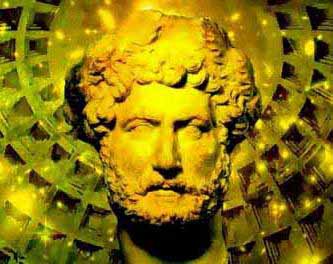
A new report in a scholarly journal supports the long-held theory by many experts that Emperor Hadrian designed his famous circular, domed Pantheon temple to serve as a solar calendar.
Built by the Emperor Hadrian and completed in 128 AD, the classic structure features the largest unsupported concrete dome in the world which is punctured by a 10-meter-wide (30 ft) hole called the oculus. This opening is the temple's only source of natural light. It has long been speculated that rays of sunlight shining through the oculus had some symbolic nature. The new report supports that theory.
The report published in the journal Numen by Giulio Magli, an historian of ancient architecture from Milan Polytechnic, and Robert Hannah, a classics scholar from the University of Otago in New Zealand, claims that at precisely midday during the March Equinox, a circular shaft of light shines through the oculus and illuminates the Pantheon's entrance.
The size and shape of the beam of light matches, down to the last inch, a semicircular stone arch above the doorway. A similar effect is seen on April 21st, which the Romans celebrated as the founding date of their city, when at midday the sun strikes a metal grill above the doorway, flooding the colonnaded courtyard outside with light.
The dramatic displays would have been seen by the Romans as elevating an emperor into the realm of the gods — a cosmological affirmation of his divine power as he entered the building, which was used as an audience hall as well as a place of worship.
He was in effect being "invited" by the sun to enter the Pantheon, which as its name suggests was dedicated to the most important deities of the Roman world.
"The emperor would have been illuminated as if by film studio lights," said Magli. "The Romans believed the relationship between the emperor and the heavens was at its closest during the equinoxes. It would have been a glorification of the power of the emperor, and of Rome itself."
He explained that during the darker winter months the beam illuminates only the vaulted dome. However, at noon on the equinoxes it reaches the floor and on April 21 the beam fully illuminates the entrance at midday.
Construction of the Pantheon was started in 27 BC by Agrippa and his name is still visible over the entrance, although it was not finished until 128 AD by Hadrian, who is believed to be directly responsible for the unprecedented circular dome — an architectural innovation which lives on in such structures as St Peter's Cathedral and the U.S. Capitol. The word Pantheon means "to every god" and the circular interior has niches for all the major deities of Rome.
The two experts first proposed their theory in 2009, but the published report is the first written evidence of their claims. Giulio Magli is a self-styled expert in "ancient archaeo-astronomy" and seeks to prove that structures built by the Egyptians, Mayans, Incas, Aztecs and other ancient cultures were often aligned with the stars. Research by another expert recently claimed that portions of Hadrian's Villa are also aligned to celestial events (see news report below).
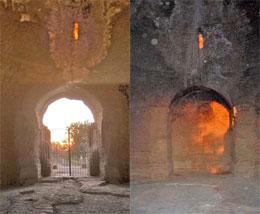
A tower at Hadrian's Villa which archaeologists hold to be the Emperor's own private observatory is in fact aligned to the solstices, according to a report in the journal Nature citing an Italian expert.
Until now, archaeologists had been mystified by the layout of the sprawling complex of marble baths, banquet halls, luxurious residences, gardens, shrines and unidentified structures 30 kilometers outside Rome.
But Marina De Franceschini, an Italian archaeologist, believes that the mystery-shrouded Rocca Bruna Tower, long held to be Hadrian's private observatory, is in fact aligned so as to produce sunlight effects for the seasons.
De Franceschini says that during the summer solstice, rays of light pierce the tower and another of the villa's buildings. In the Rocca Bruna Tower, dawn sunlight during the summer solstice enters through a wedge-shaped slot above the door and illuminates a niche on the opposite side of the interior (image courtesy nature.com). And in a temple of the Accademia building, De Franceschini has found that sunlight passes through a series of doors during both the winter and summer solstices.
"The alignments gave me a new key of interpretation," says De Franceschini, who adds that the two buildings are connected by an esplanade that was a sacred avenue during the solstices. Based on ancient texts describing religious rituals and study of recovered sculptures, she thinks the sunlight effects were linked to religious ceremonies associated with the Egyptian goddess Isis, who was adopted by the Romans.
De Franceschini, who works with the University of Trento in Italy, will publish a book this summer describing the archaeo-astronomical work. She credits two architects, Robert Mangurian and Mary-Ann Ray, for initially noticing the light effect in Rocca Bruna.
According to nature.com, Robert Hannah, a classicist from the University of Otago in New Zealand, says that De Franceschini's ideas are plausible. "They're certainly ripe for further investigation," he says.
Hannah, who is currently seeking to pin down alignments associated with star rises in Greek temples in Cyprus, believes that the Pantheon, a large temple designed by Hadrian in Rome with a circular opening at the top of its dome, also acts as a giant calendrical sundial, with sunlight illuminating key interior surfaces at the equinoxes and on the spring equinox on April 21st, the city's birthday.
Few classical buildings have been investigated for astronomical alignment, says Hannah, partly because it is much easier to check for alignments in prehistoric structures such as Stonehenge, which do not have potentially contradictory artefacts.
The report on nature.com also said that Jarita Holbrook, a cultural astronomer at the University of Arizona in Tucson, is also not surprised by the solar alignments at Hadrian's villa. They are "a common part of most cultures", she says. But, she adds, it's also easy for buildings to be coincidentally aligned with astronomical features.
De Franceschini spends every solstice at Hadrian's villa, seeking further verification.
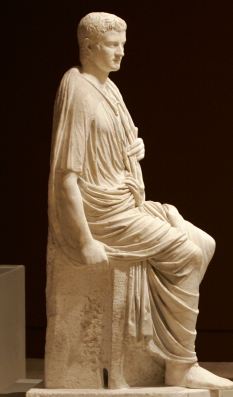
Archaeologists in Italy are breathing a sigh of relief after a hitherto unknown statue of Caligula was seized from a gang of art smugglers by eagle-eyed customs officials.
The massive statue of Caligula sitting on a throne (much like the one at the Louvre pictured here), had been illegally excavated, cut up, and was about to be shipped abroad when the police intervened during a routine customs spot-check of a truck at a loading dock at a port not far from Rome.
Police arrested two men, dubbed "tomb raiders" by the Italian press, who said they unearthed the statue near Lake Nemi, just south of Rome, where Caligula's "pleasure barges" used to be anchored. The "pleasure barges" were veritable floating palaces and temples.
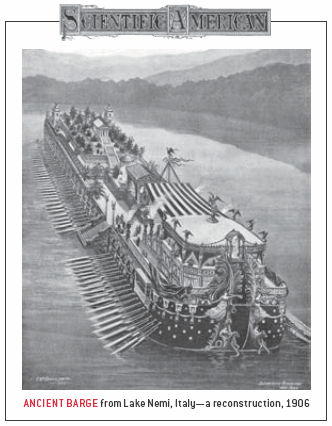
Under orders of Benito Mussolini the lake was drained and the vessels were painstakingly retrieved and lovingly restored in a specially built museum — only to be destroyed in a fire which egulfed the museum in 1944 attributed to retreating German occupation forces. Now only a few charred timbers at the Nemi Antiquarium recall the lavish splendor of the vessels.
The statue depicts the Emperor wearing robes and seated on an elaborate throne in the image of the god Jupiter.
Significantly, it shows him wearing "caliga" footwear like the boots worn by Roman legionaries. His warrior father Germanicus was hugely popular with the Legions. Accompanying his father Germanicus on military visits as a boy, he had charmed soldiers by wearing tiny military boots. The troops nicknamed him "little boots" — Caligula — and the name stuck. His real name was Gaius Julius Caesar Augustus Germanicus.
Caligula, who reigned from 37 to 41 AD, has gone down in history as a crazed and power-hungry sex maniac who proclaimed he was a god — or goddess on days when he dressed in drag as Venus.
Caligula once set sail for Britannia on a war of conquest, then suddenly turned back and ordered his troops to collect seashells which he paraded before the citizens of Rome as booty from his victory over Poseidon.
He demanded that his horse, Incitatus, be given a marble feeding trough, robes of imperial purple and be addressed as "Consul of Rome" during state banquets to which the horse was invited.
At a gladiator show, the number of condemned men slain by beasts was insufficient to his liking, so he ordered a number of spectators to be thrown to the man-eating animals.
Once when Caligula fell ill, a Patrician prayed to the Gods, offering his own life that the emperor might live. When Caligula recovered, he reminded the man of his pledge, saying his fellow Gods would consider it a sacrilege if both of them remained alive. So the man was compelled to commit suicide.
In early 41, Caligula was assassinated as the result of a conspiracy involving officers of the Praetorian Guard, as well as members of the Roman Senate and of the Imperial court. The conspirators' attempt to use the opportunity to restore the Roman Republic was thwarted when the Praetorian Guard discovered Caligula's lame and stuttering old uncle Claudius cowering and twitching behind a curtain and, almost as a joke, proclaimed him emperor on the spot.
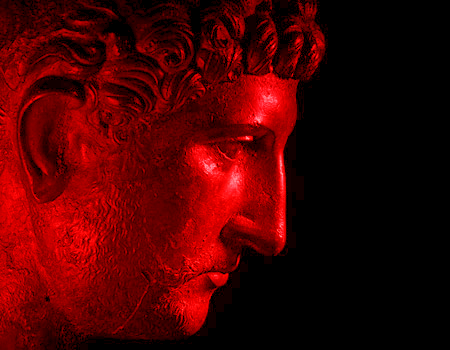
Hadrian's Villa is "crumbling due to neglect and lack of funds," according to a shocking report which is making headlines in Italy amidst growing sex and corruption scandals involving Prime Minister Silvio Berlusconi.
Parts of the villa have had to be closed off to tourists because they are in danger of collapse, an Italian paper reported.
The historic site at Tivoli, 24 kilometres (15 miles) from Rome, receives only 370,000 euros ($530,000) a year to maintain the villa and its grounds, Il Corriere della Sera reported. But those responsible for the site say it needs at least 2.5 million euros, the paper said.
The experts complained that over the past three years they had received only 1.5 million euros of the 6.7 million they needed — while projects for Berlusconi cronies in northern Italy were lavished with many millions more.
As a result, they had had to cordon off more and more areas with metal barriers and signs warning of the risk of collapse.
Yet Hadrian's residence is one of the 45 sites in Italy to which UNESCO has given World Heritage status. It is perhaps the most complex and important example of Roman architecture that has survived to the present day.
Sprawling across 80 hectares (nearly 200 acres), it is bigger than Pompeii. In view of its condition — the uncovered remains are exposed to the elements — Villa Adriana requires thorough, ongoing maintenance.
That was why world-renowned archaeologist Andrea Carandini told the Corriere della Sera that, after the collapse of the Schola Armatorum at Pompeii: "All sites like Pompeii, Herculaneum and Villa Adriana are permanently at risk."
Villa Adriana was given World Heritage status in December 1999, but the government failed to capitalize on that status. Instead, paying visitors have dropped by nearly 50 per cent over the past decade. In 2000, 187,202 came to see it but by 2010 the figure had dropped to 108,811.
Equally disastrous is the plunge in the overall number of tourists, paying and non-paying. The 323,231 who came in 2000 fell to 229,885 by 2010.
What's the reason for the decline? According to scholar Federica Chiappetta, author of I percorsi antichi di Villa Adriana (The Ancient Paths of Villa Adriana), there has been a chronic failure to publicise the site's "extraordinary historical and architectural significance". Andrea Carandini also points out the "terribly off-putting" access to Villa Adriana and Tivoli with inadequate transportation connections and poor roads.
One expert, Federica Chiappetta, told the paper that as well as the sad state of the site, tourists had also been put off by the lack of visitor-friendly information and facilities at the site itself.
The newspaper summed up the situation by saying, "At the root of everything is Italy's inability to join the dots. In no other country in the world would the home of one of the most important figures in human history be so totally excluded from the tourist circuit or reduced to picking up the crumbs from the public purse to stave off ruin. If this is how we treat the residence that the Emperor Hadrian started to build in 117 AD, you might be wondering what state the rest of our heritage is in."
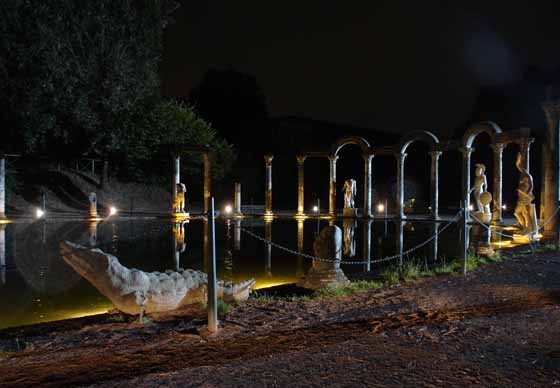
But in fact, the newspaper article went on to say, the situation is better in Lombardy, home province of Italian Tourism Minister Michela Vittoria Brambilla. He announced in May that the ministry would be giving 7.3 million euros in funding for the Lombard region's "projects of excellence".
Brambilla's announcement prompted a civil servant at the Ministry for the Cultural Heritage to remark: "Maybe all we need to do to save Villa Adriana is move it to Lombardy. Along with one or two ministries."
The villa was built between 117 and 138 AD on the orders of Emperor Hadrian. UNESCO calls it "a masterpiece that uniquely brings together the highest expressions of the material cultures of the ancient Mediterranean world."
Many experts believe the LOST TOMB OF ANTINOUS is probably located in the Villa compound.
Our own Flamen Antinoalis Antonyus Subia firmly believes the Blessed Boy is buried here. Antonyus notes that Hadrian was a gifted architect and that the design of the Villa Adriana is full of Sacred Symbolism. Antonyus Subia explains his thinking this way:
"When a visitor arrived at Hadrian's Villa, the very first thing they would encounter, placed immediately on the Right side of the entrance, was the small, enclosed Temple complex, with the Obelisk of Antinous rising from the center between two small temples, behind which was a semicircular colonnade.
"In the middle of the semicircle was a recessed chamber...a sanctuary, perhaps, that held something very sacred...Hadrian wanted everyone to pass before the sacred treasure.
"Is this The Lost Tomb of Antinous? If so, what a small tomb for The Beloved...and why would you place The Tomb of The Beloved in your Driveway? Or can it be that the Entrance was a Very sacred Place? The modern path behind the Temple complex leads to the reflecting pool and the area known as the Canopus Grotto, where many Antinous statues were found when it was first excavated 200 years ago."
The LOST TOMB OF ANTINOUS may be hidden amongst the crumbling ruins of Hadrian's Villa. Behold...the Temple of Antinous!

Archaeologists in Britain have unearthed dozens of mysterious circular huts close to Hadrian's Wall which they believe could have been a refugee camp for tribespeople fleeing south from a breakdown of society north of the imperial border in the 3rd Century AD.
The excavation at the site in Hexham, Northumberland, has unearthed various finds from Roman Britain including letters, corpses of murder victims and shoes — indeed, the largest collection of shoes from the Roman Empire ever found anywhere.
Archaeologists were initially puzzled to unearth the circular foundations of temporary but well-built structures on the site of an earlier fort within the sprawling perimeter of the Roman fortress of Vindolanda.
They conjectured that the huts were built during the invasion of Scotland under Emperor Septimius Severus (AD 208-211).
The director of excavations at the site, Dr Andrew Birley, said: "These are very unusual buildings and it looks as though they may number into the hundreds. Events clearly took place here on a large scale to lead to this sort of construction."

The find has intrigued archaeologists at the site since Roman soldiers did not build round houses anywhere elsewhere in the Empire.
They are interested as to why the Roman army would go to such lengths to accommodate the unusual structures.
Dr Birley told the BBC, "These are remarkable structures to be found inside a Roman fort, unique in fact. They are the sort of building you might expect to find north of Hadrian's Wall in this period, used by small farming communities."
He suggested the may have housed civilian refugees, saying, "It is quite possible that what we have here is the Roman army providing for these farmers — creating a temporary refuge for the most vulnerable people from north of the wall."
Birley noted that people in strife-torn hotspots today face similar retribution from rebels. It was no different in frontier Roman Britain, he said.
"Those people may have helped to feed the army and traded with the soldiers, and would have been regarded as being traitors and collaborators in the eyes of the rebellious tribes to the north," said Dr Birley. "It would make a certain sense to bring them behind the curtain of Hadrian's Wall and protect them while the fighting continued, as they would have had real value to the Romans and they certainly tried to protect what they valued."
The Gods must be smiling on Hadrian's Wall these days because it is in the news headlines more than ever. It is the focus a a major new feature-length movie (released this month on DVD) as well a number of museum exhibitions. The Eagle opened at cinemas worldwide in March. It is the film of Rosemary Sutcliff's much-loved children's novel The Eagle of the Ninth. It's the story of a young centurion, Marcus Aquila (played by Channing Tatum), who sets off to the uncharted realms north of Hadrian's Wall with his British slave (played by Jamie Bell) in 140 AD on a quest to restore the honour — and recover the golden eagle standard — of the Ninth Legion, commanded by his father, which had disappeared without trace in Scotland 20 years earlier. The fate of the "Lost Ninth" has long baffled historians.

In related headlines, nine of the famous Vindolanda Tablets — rare examples of Roman writing in ink on wood — were placed on special exhibit recently, in collaboration with the British Museum. Also, the nearby Roman Army Museum has reopened after a complete overhaul.
The Vindolanda Tablets are small sheets of wood which Roman soldiers used as "postcards" or letters home. These shards of brittle wood are as important to historians as any pristine statue or other monument.
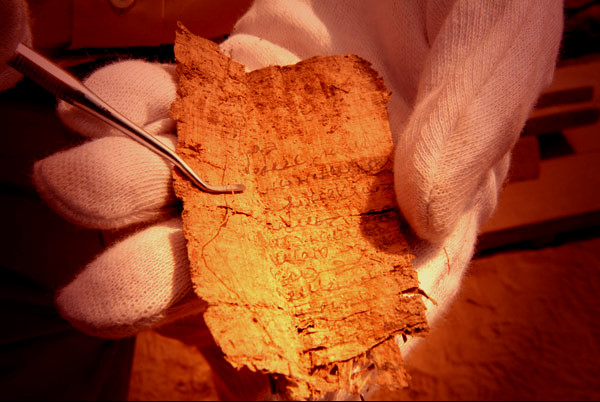
Now known as the Vindolanda Writing Tablets — after the Roman Fort where they were found — the more than 1,000 pieces of birch, alder and oak give an unparalleled, moving and often very funny insight into the life of the Roman soldier stuck miles from home at the turn of the 2nd Century AD.
The letters, found 40 years ago, tend to be from officers and were found in the ruins of the praetorium, the residence of the officers commanding the Vindolanda units from AD90 to 120, just before Hadrian's Wall was built between 122 and 130 AD, which coincide with years when Hadrian and Antinous traveled together. Some Antinoian experts believe it is even possible that Antinous visited Britain.
In other Hadrian's Wall news, a big fort excavation began earlier this month at Maryport, Cumbria, and a new Roman Gallery has just opened at Carlisle's Tullie House Museum. The museum currently is hosting a small touring exhibition about life in frontier Britain around the time in which the movie The Eagle is set.
The excavations at Maryport got off to a successful start on the first day of digging in early June with the discovery of a Roman altar fragment. A student volunteer from Newcastle University found the piece of carved scrollwork. Archaeologist Tony Wilmot, who is leading the excavations alongside professor Ian Haynes of Newcastle University, said: "It is early days yet but it's all looking very promising and we are hoping for good things in the next two months."
He told the News & Star newspaper: "To find something like this on the first day was great for the volunteers. We are getting hints that there is a lot of interesting items there."
The 28-strong team of volunteers is working to unravel the mystery surrounding a unique cache of 17 altars discovered at Maryport in 1870. They had been buried in a series of pits to the north and east of the fort. The site has remained untouched since 1870. Experts hope that revisiting the area will help them to construct a more complete picture of this internationally important site. Watch this column for updates on this major dig.

Archaeologists in Egypt have discovered ancient red-painted hieroglyphic symbols deep inside one of the mysterious "air shafts" in the Great Pyramid.
The markings are beyond a tiny stone door with copper handles which had blocked previous photographic exploration of the shaft which connects the Queen's Chamber with the outer face of the Great Pyramid. But now a team of British and French experts have used a flexible robot camera small enough to fit through a hole in the stone doorway at the end of the narrow shaft to send back digital images of the markings, which have lain unseen for at least 4,500 years.
In addition to the glyphs are long straight painted red lines along the stone that may have been made by masons when the chamber was being built. Similar red-paint glyphs have been found elsewhere in the Great Pyramid, which is otherwise entirely devoid of any markings or inscriptions of any kind. The painted glyphs are thought to have been inventory symbols used by the stone masons to identify the quarry work gang, the date and maybe guidelines for cutting and placing the stone block. But the new glyphs are hard to identify and could possibly have some religious or astronomical significance, experts said.
The robot camera was dubbed Djedi by Egyptian Antiquities Minister Zahi Hawass after the magician/priest Khufu consulted when planning the layout of this pyramid. Besides being a proper name, Djedi was an Ancient Egyptian word meaning "double strength" which was also used in the Star Wars movies for the order of the Djedi knights.
Djedi was small enough to fit inside the cramped confines of the Queen's Chamber "air shaft", which is extremely narrow — 20 x 20 cm (8 x 8 inches) — and is built at a sloping angle of 40 degrees and has no outside exit on the exterior of the Great Pyramid — at least no exit that has ever been found.
The Great Pyramid of Khufu is known to contain four so-called "air shafts" or narrow tunnels — two leading from the King's Chamber and two from the Queen's Chamber. However, scholars are unable to agree on what they were used for. This is partly due to problems researchers face getting into these narrow spaces. It is generally believed that they were not for ventilation but rather served a sacred mystical purpose — a symbolic purpose long since forgotten.
Dr Hawass states, "No one is sure why the builders of the Great Pyramid incorporated the four shafts into the design of Khufu's monument. Since the shafts in the King's Chamber open outside of the pyramid, I believe that Khufu's soul was meant to travel through them. The southern King's Chamber shaft was intended for Khufu to use as the sun god Ra. It opens exactly between the two boat pits to the south of the Pyramid.
"Khufu would take the two boats and use them as solar boats for his journey as the sun god through the daytime and nighttime skies — one for the day trip, one for the evening trip. The northern shaft was made for the soul of Khufu as Horus to travel to the eternal circumpolar stars.
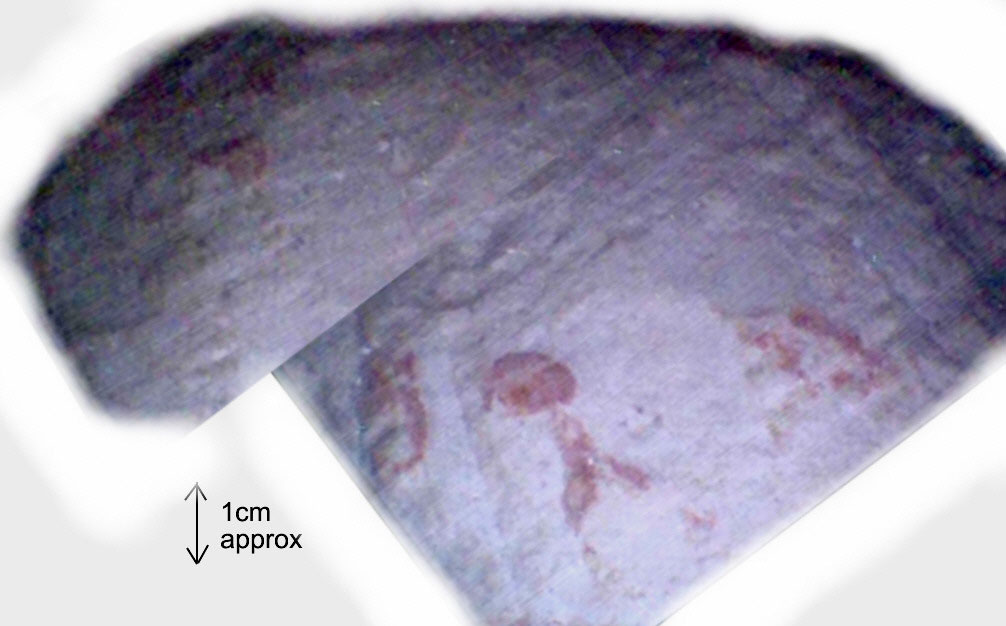
"As for the Queen's Chamber shafts, I cannot imagine that they had a religious function, as they do not seem to open to the outside of the pyramid — their outlets, if such exist, have never been found in spite of our careful searching."
An earlier camera expedition several years ago had detected a stone door with copper handles blocking one of the Queen's Chamber shafts. This time the team overcame this obstacle by using a robot explorer that could climb up inside the walls of the shaft whilst carrying a miniature "micro snake" camera that can see around corners. The bendy camera, just 8 mm diameter (3.5 inches), was small enough to fit through a small hole in the stone door at the end of the shaft, giving researchers a clear view into the dark space beyond.
When pieced together, the digital images gathered by Djedi revealed hieroglyphs written in red paint that team members suggest were made by workmen. Prior to this, researchers had only found hieroglyphs hidden in the roof of the King's Chamber, located far above the Queen's Chamber.
"We believe that if these hieroglyphs could be deciphered they could help Egyptologists work out why these mysterious shafts were built," said Dr Rob Richardson of the University of Leeds and academic leader of the team.
As well as the painted symbols, the researchers were also able to scrutinise the two mysterious copper pins or handles embedded in the "door" to the chamber that had only ever been glimpsed from the front before. The very existence of these pins — the only metal ever discovered in the Great Pyramid — has previously puzzled scholars. The detail revealed in these latest images may help to settle those questions.
Pictures of the markings have been published in the Annales du Service Des Antiquities de l'Egypte, the official publication of Egypt's Supreme Council of Antiquities, following an international mission led by the Minister for Antiquities.
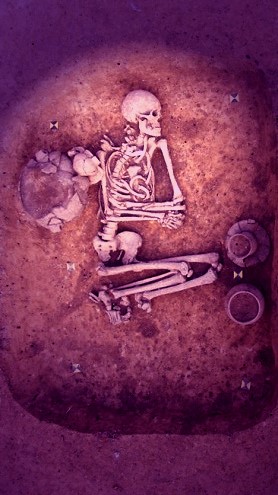
Archaeologists in the Czech Republic have unearthed the grave of what may be the remains of the oldest known homosexual or transgender man.
The prehistoric body dates to the Copper age — or 2,900 to 2,500 years ago — and belonged to the "Corded Ware" culture, named for the twisted-cord decoration on pottery. In Corded Ware society men were buried buried with weapons, hammers and flint knives, and their bodies were positioned on their right side with their heads facing west.
The "gay caveman" was found buried in a way normally reserved only for women during the Copper Age. He was interred on his left side with his head facing east, with no weapons or jewelry but with household jugs placed at his feet — almost always reserved for women in the region during that time.
"We found one very specific grave of a man lying in the position of a woman, without gender specific grave goods, neither jewelry or weapons," said lead archaeologist Kamila Remisova Vesinova of the Czech Archaeological Society.
"From history and ethnology, we know that people from this period took funeral rites very seriously, so it is highly unlikely that this positioning was a mistake," she added.
"So we think based on mainly archeo-ethnological data that it could be a member of the so-called third gender, which were people either with different sexual orientation or transsexuals or just their inner identity was different from the rest of the society," she said. "What we see here does not add up to traditional Corded Ware cultural norms."
Semradova told reporters that the "third gender" discovery mirrored an earlier case, in which a female warrior dating from the Mesolithic period was found to have been buried as a man. She also noted Siberian shamans were buried in a similar fashion to the "gay caveman," but usually with richer funeral accessories to depict a higher social status.
"But this later discovery was neither of those, leading us to believe the man was probably homosexual or transsexual," Semeradova added.
The male grave with no gender-identifying hints came as a surprise to the archeologists given that the Corded Ware culture it follows has been identified as strictly separating male and female burial procedures.
While the tabloids insist on calling him a "cave man," he was not a Stone Age man who lived in caves, but actually lived during the much later Copper Age when agriculture and trading had already led to creation of towns and cities. When this man lived, Troy had already fallen and the Egyptian pyramids were already more than 1,000 years old.
Homosexuality, as Westerners think of it today, comes with a lot of added societal baggage that was unknown to prehistoric humans. "Gender transformers" existed in most ancient societies. Some Native American tribes, for example, have room for as many as seven different genders in addition to Berdaches. In parts of modern-day Indonesia, there are five genders.
Biological males in many cultures throughout history have occupied a sort of liminal space between the two sexes — dressing and acting like women, but their behavior having no bearing on their sexual orientation or who they slept with. These "third-gender" people have often been accorded special spiritual or shaman status in their societies.
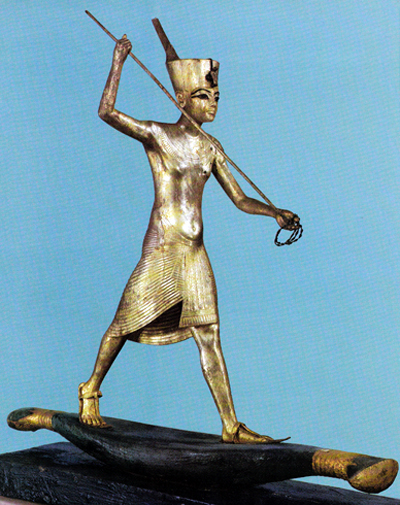
Egyptian looters who raided the Cairo Museum during the unrest that toppled Hosni Mubarak have escaped with 18 items, including two gilded wooden statues of Tutankhamun and a priceless statue of Tut's father Akhenaten and artefacts of his grandfather Yuya, along with a statue of Akhenaten's Queen Nefertiti.
The break-in occurred on January 28th, as protesters clashed with police early on in the turmoil and burned down the adjacent headquarters of Mubarak's ruling party. A handful of looters climbed a fire escape to the Cairo Museum roof and lowered themselves on ropes from a glass-paneled ceiling onto the museum's top floor.

Around 70 objects — many of them small statues &mdash were damaged, but it was not known whether anything was missing.
Zahi Hawass, Egypt's antiquities minister, said the museum's database department determined 18 items were gone.
He said investigators searching for those behind the thefts are questioning dozens of people arrested over several days after last month's break-in.
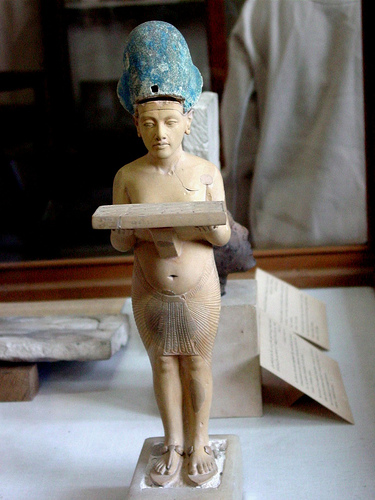
The most important of the missing objects include a gilded wooden statue of the 18th Dynasty King Tutankhamun being carried by a goddess and another gilded wood statue of Tutankhamun harpooning. The pillagers shattered the glass display case and broke off the harpooning sculpture at the legs, leaving the feet still stuck to the skiff-boat base.
Also missing is a limestone statue of the Pharaoh Akhenaten standing and holding an offering table. The looters also took a statue of Nefertiti making offerings, a sandstone head of an Amarna princess, a stone statuette of a scribe from Amarna, eleven wooden shabti statuettes of Yuya, and a Heart Scarab of Yuya. Akhenaten is the so-called heretic king who tried to introduce monotheism to ancient Egypt.
Tarek el-Awady, the museum director, said the looters did not manage to break into the room containing the gold funerary mask of Tutankhamun and other items from his tomb in the Valley of the Kings.
In another terrible turn of events, on the night of February 11th an archaeological storage facility in Dahshur was broken into. It is called De Morgan's Magazine. This magazine contains large relief blocks and small Egyptian artifacts.
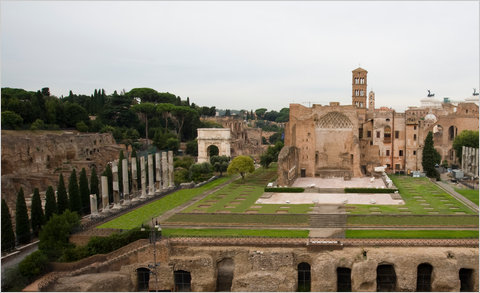
Ancient Rome's biggest temple has reopened to the public after 26 years of restoration work.
The massive Temple of Venus and Roma, in the heart of the Roman Forum and a stone's throw from the Colosseum, was designed and commissioned by the Emperor Hadrian in the 2nd Century AD.
In order to build the temple, erected on the remnants of Emperor Nero's Domus Aurea, the enormous statue known as the Colossus of Nero was moved and placed near the amphitheatre, which shortly afterwards became known as the Colosseum. Unimpressed by his emperor's architectural skills, Hadrian's most brilliant architect, Apollodorus, made a scornful remark on the size of the seated statues within the cellae, saying that they would surely hurt their heads if they tried to stand up from their thrones. Apollodorus was banished and executed not long after this.
Construction of the temple began in AD 121, and it was officially inaugurated by Hadrian in 135. The years-long restoration of the temple was particularly welcome in a week in which a house used by gladiators prior to combat collapsed into a pile of rubble at Pompeii, prompting a national debate on Italy's management of its ancient sites (see news item below).
The Temple of Venus once had dozens of 15-meter-high (50 ft) white marble columns flanking an enormous nave and a coffered vaulted ceiling, but only 16 are still standing. The temple was dedicated to Venus, the goddess of love, and Roma, the patron goddess of Rome, and contained giant statues of both. While most of the columns surrounding the temple have disappeared over time, it is still possible to see the detailed carving on the remaining temple wall as well as some of the restored patterned tiles.
Nearly 100 meters long (350 ft) and more than 60 meters wide (150 ft), it was used as a car parking lot until the 1980s, when restoration work commenced. Though closed to the public until now, the temple has been used since John Paul II's papacy as a platform for Good Friday ceremonies when the pope leads pilgrims in meditations on the Stations of the Cross.
"This monument should be the envy of the world, but it was completely abandoned and left in the most degraded state," Francesco Maria Giro, the junior culture minister, said at the opening ceremony.
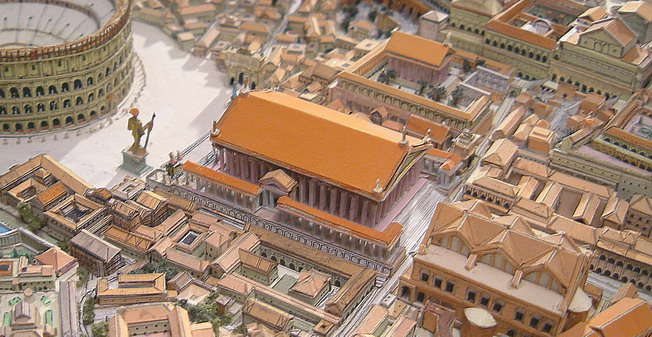
"We're restoring to Rome one of the most important symbols of the power and greatness of the Roman Empire," said Claudia Del Monte, the architect in charge of repairs.
"We've worked meticulously to restore every single stone of the temple that remains, cleaning away the smog and filth caused by years of urban misuse.
"When we began restoring the stucco we found traces of gold leaf that would have adorned the apses above the statues. Though the sculptures have long been lost, we've done our best to return the temple to its former glory," she said.
The restoration work has included repairs to the temple floor and cleaning up a nearby sewer.
Entrance to the temple will be included in the 12 euro ($16) tickets which give visitors access to the Colosseum, the Forum and the Palatine Hill.
The collapse at Pompeii set off a furious debate over the neglect of Italy's ancient sites, with archaeologists warning that decades of mismanagement could lead to more treasures being lost.
Opposition parties called on Sandro Bondi, the culture minister, to resign. Bondi said he would gladly resign if he felt responsible for the collapse. But as he doesn't, he won't.
Hundreds of libraries and museums staged a one-day closure this week in protest at budget cuts introduced by the cash-strapped government of Silvio Berlusconi since he returned to power in 2008.
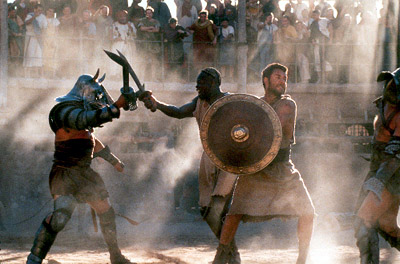
Pompeii's famous Domus Gladiatoria (House of the Gladiators) has collapsed amid reports that three-quarters of the ancient Roman city of Pompeii is "at risk" of collapse and 40 per cent of its buildings in need of highly urgent restoration work.
Only 30 per cent of Pompeii's ancient buildings are in good condition, while 40 per cent are crumbling, according to a 2005 report cited by Naples daily Il Mattino newspaper.
The Domus Gladiatoria, the Roman gymnasium for gladiators, crumbled on November 6 in the ancient city southeast of Naples. And it will not be the last, Italian Culture Minister Sandro Bondi warned.
"More collapses may occur," Bondi told Italy's lower house of parliament in Rome. "Problems affecting Pompeii and other issues regarding our cultural heritage have been going on for decades without anyone being able to fix them or plan an effective strategy."
Bondi was asked to testify after the opposition called for him to resign and accused the government of cutting funding for heritage sites. He said he would gladly resign if he felt responsible. But he placed the blame on lapses by earlier governments.
The world's largest archaeological site, Pompeii was destroyed in 79 A.D. when Mount Vesuvius erupted, killing thousands of people and burying the city in volcanic ash. In July 2008, Italy declared a state of emergency to protect the buried ancient city, naming a special commissioner to oversee its preservation and management.
However, in the past two years all archaeological oversight was given to political cronies of President Silvio Berlusconi, many of them without any familiarity with the field; funds were cut to zero (Parma's museum was the first to close for lack of personnel, others are following suit); the site of Pompeii was entrusted to the infamous mob-connected head of Civil Protection, Guido Bertolaso, who introduced organized crime into earthquake-prostrate L'Aquila.
Meanwhile, the disintegration of ancient site has accelerated. Earlier this year, plaster fell from a portal at the Colosseum and a portion of the ceiling of Roman emperor Nero's famed Domus Aurea (Golden Palace) collapsed under the weight of rain-sodden soil (see reports below).
As the old Italian adage goes, "All we've got left are eyes to cry with."
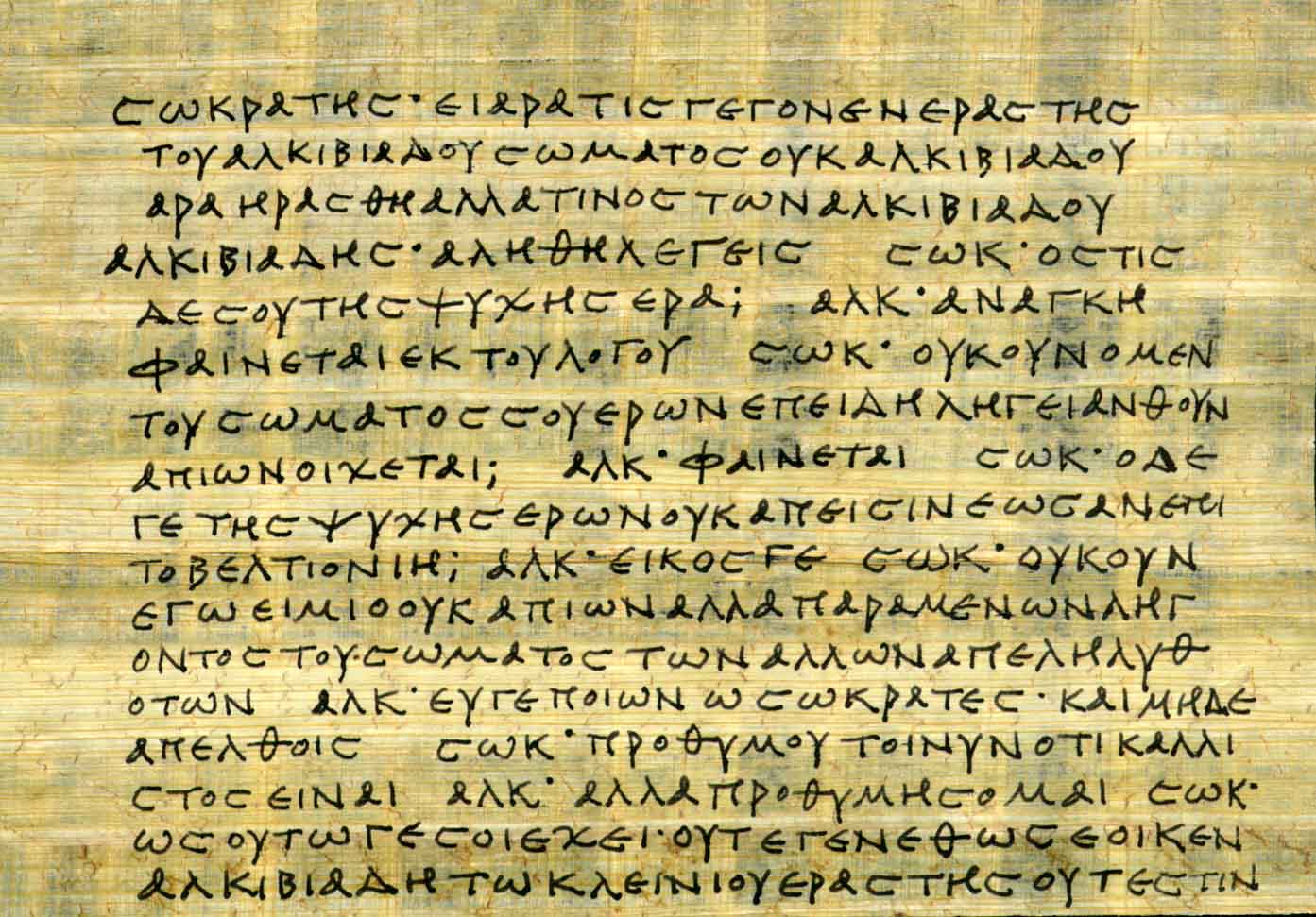
A science historian at the University of Manchester has cracked "The Plato Code" — the long disputed secret messages hidden in the great philosopher's writings.
Dr. Jay Kennedy's findings are set to revolutionise the history of the origins of Western thought, according to a news release from that British university announcing the breakthrough.
Dr Kennedy, whose findings are published in the leading US journal Apeiron, reveals that Plato used a regular pattern of symbols, inherited from the ancient followers of Pythagoras, to give his books a musical structure.
A century earlier, Pythagoras had declared that the planets and stars made an inaudible music, a "harmony of the spheres". Plato imitated this hidden music in his books, according to the startling new findings.
The hidden codes show that Plato anticipated the Scientific Revolution 2,000 years before Isaac Newton, discovering its most important idea — the book of nature is written in the language of mathematics. The decoded messages also open up a surprising way to unite science and religion. The awe and beauty we feel in nature, Plato says, shows that it is divine — discovering the scientific order of nature is getting closer to the Gods.
"Plato's books played a major role in founding Western culture but they are mysterious and end in riddles," explains Dr. Kennedy, who is on the faculty at Manchester's Faculty of Life Sciences. In antiquity, many of his followers said the books contained hidden layers of meaning and secret codes, but this was rejected by modern scholars.
He says, "It is a long and exciting story, but basically I cracked the code. I have shown rigorously that the books do contain codes and symbols and that unraveling them reveals the hidden philosophy of Plato. This is a true discovery, not simply reinterpretation."
He adds that his discovery will transform the early history of Western thought, and especially the histories of ancient science, mathematics, music, and philosophy.

Dr. Kennedy spent five years studying Plato's writing and found that in his best-known work, The Republic, he placed clusters of words related to music after each twelfth of the text — at one-twelfth, two-twelfths, etc. This regular pattern represented the twelve notes of a Greek musical scale. Some notes were harmonic, others dissonant. At the locations of the harmonic notes he described sounds associated with love or laughter, while the locations of dissonant notes were marked with screeching sounds or war or death. This musical code was key to cracking Plato's entire symbolic system.
Dr. Kennedy, a researcher in the Centre for the History of Science, Technology and Medicine, says: "As we read his books, our emotions follow the ups and downs of a musical scale. Plato plays his readers like musical instruments."
However, Plato did not design his secret patterns purely for pleasure — it was for his own safety. Plato's ideas were a dangerous threat to Greek religion. He said that mathematical laws and not the Gods controlled the universe. Plato's own teacher had been executed for heresy. Secrecy was normal in ancient times, especially for esoteric and religious knowledge, but for Plato it was a matter of life and death. Encoding his ideas in secret patterns was the only way to be safe.
Dr. Kennedy says, "Plato is smiling. He sent us a time capsule. This is the beginning of something big. It will take a generation to work out the implications. All 2,000 pages contain undetected symbols."
The Platonic system was essentially a unification of the social inquiry of Socrates with the cosmic ramifications of the teachings of Pythagoras. In the vision of Love that Plato expounded, Venus Urania (Celestial Love) is glorified as highest form of human affection, above the earthly requirements of procreation. The love between two men, what is innocently called Platonic Love, was considered by Plato to be the most divine form of relationship.
The Emperor Hadrian, in all ways the most Platonic of all Emperors, the veritable manifestation of the Philosopher King as glorified by Plato in The Republic, was demonstrating the meaning of Venus Urania — for all the world to see — in his passion for Antinous. For the beautiful light in which Plato illuminated the inner nature of homosexual love, Plato is venerated in the 21st Century as a divine Saint of Antinous in the modern Religion of Antinous.
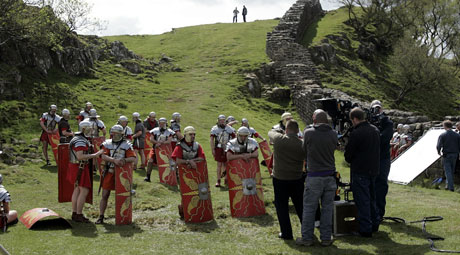
A dramatic new 3-D documentary film about the Romans is currently being shot on Hadrian's Wall.
According to a report in the Newcastle Journal, the film is titled "Eagle's Eye: Edge of Empire" and focuses on a Roman Legionnaire called Aquila and features "soldiers" played by members of a leading Roman re-enactment society, The Ermine Street Guard. An on-location photo of the film shoot (left) appeared in weekend editions of The Journal
The $500,000 film commissioned by The Vindolanda Trust is being produced by the award-winning, Newcastle-based company, Dene Films, according to The Journal.

It comes amidst a $10 million project to renovate the Roman Army Museum near Greenhead and build new facilities at the Roman fort of Vindolanda.
Trust director Patricia Birley told the newspaper: "The new film will be a journey along Hadrian's Wall and it will be a picture that speaks a thousand words. There is a huge amount of historical information woven into the film and will also be thoroughly enjoyable."
Dene Films began shooting "Eagle's Eye" at Walltown Craggs last weekend, and different locations along the Wall are providing backdrops for the film, which charts the story of young auxiliary recruit Aquila. A specially-equipped helicopter will film the views of the wall "seen" by Sima, a white-tailed sea eagle whose bird's-eye view will enhance the film's 3-D effects.
Steve Salam, managing director Dene Films told The Journal: "The film aims to transport people back to Roman times and hopefully they will get a real experience of the wall."

Computer-generated images will be added later to recreate the World Heritage Site in its 2nd Century AD glory.
The film will be at the heart of the new exhibition space at the Vindolanda Roman Army Museum, while the centerpiece of Vindolanda's new museum will be the temporary return of nine precious Vindolanda Tablets from the British Museum.
A state-of-the-art display case, being made to British Museum specifications, will allow the Roman ink-on-wood "postcards" to be seen at Vindolanda, where they were discovered. Patricia said: "The writing tablets are one of the British Museum's greatest treasures and will be the pinnacle of an exhibition that showcases Vindolanda's fabulous Roman collection."
Roman Vindolanda and The Roman Army Museum are open as normal this year. Renovation will be complete by Spring 2011 when the new film will open, according to the report in today's Newcastle Journal.
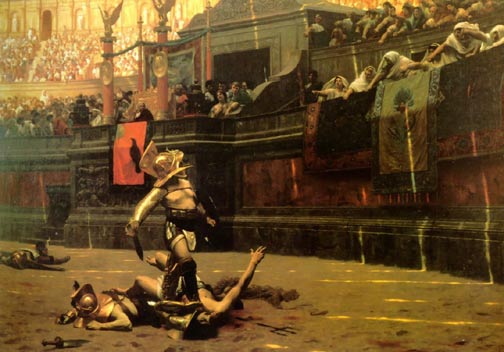
Archaeologists in Rome have demanded immediate restoration work after three large pieces of ancient plaster fell from the ceiling of a portal to the Colosseum and plunged through safety nets to the ground.
Luckily, the incident occurred at dawn Sunday when no tourists were inside the structure, officials said. Archaeologists warned that disaster had only narrowly been averted and that visitors could have been badly injured or even killed by the falling debris.
The three slabs crashed through a wire protection net which was supposed to have prevented such accidents, but which is more than 30 years old.
The plaster fell from a section of ceiling in one of the stone entrance ways through which spectators used to file to watch gladiators take on wild animals, prisoners-of-war and each other.
A $40 million restoration project is planned, but Rome city council is still trying to raise funds from the private sector in Italy and abroad to finance the work.
Archaeologists said the near miss should act as a wake-up call for the sad state of the arena, which was started by Emperor Vespasian in 72 AD and subsequently suffered damage from earthquakes and centuries of pillaging.
"If the collapse had happened during opening hours, it could have hit one of the thousands of visitors who, especially on Sundays, crowd into the Colosseum," said Andrea Carandini, the president of the Council for Culture and Heritage.
Attempts in the past to strengthen the Colosseum had been woefully inadequate, said Andrea Carandini, the president of the Council for Culture and Heritage. "They procrastinated for decades and decades," he said. "The problems of the Colosseum and of other ancient monuments in Rome were never taken by the horns. Sooner or later something was going to happen."
The Colosseum, which attracts 3.2 million visitors a year, is not the only ancient monument in Rome that is crumbling.
In March this year, the roof of the Domus Aurea, a magnificent palace built by Emperor Nero but covered up by succeeding emperors, caved in, damaging the interior (see entry below).
In 2001, a section of the Aurelian Wall, the stone ramparts which were built to defend Rome from barbarian invasion in the 3rd century AD, collapsed as a result of heavy rain and subsidence.
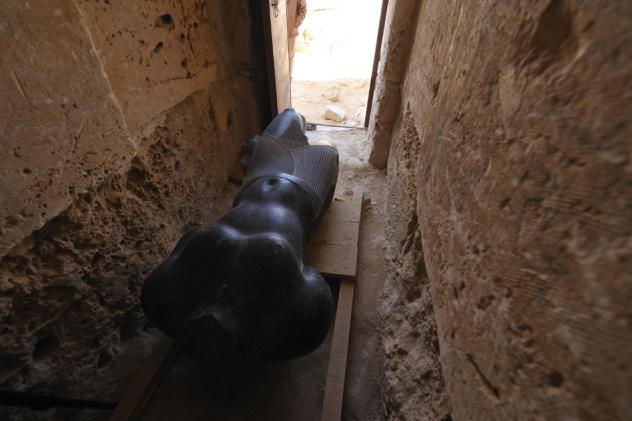
Archaeologists searching for the LOST TOMB OF CLEOPATRA at Taposiris Magna, a site west of Alexandria, have discovered a huge headless granite statue of a Ptolemaic king, and the original gate to a temple dedicated to the god Osiris
The statue was found in catacombs below the ruins of ancient Taposiris, a Sacred City a few kilometers inland and slightly west of Alexandria. It is there that a team of Egyptian and Dominican archaeologists hope to find the resting place of Cleopatra.
Dr. Zahi Hawass, head of Egypt's Supreme Council of Antiquities, says that the life-size sculpture, which is a traditional figure of an ancient Egyptian pharaoh wearing collar and kilt, could represent Ptolemy IV, the pharaoh who constructed the Taposiris Magna temple.
He added that the statue is very well preserved and is "one of the most beautiful statues carved in the ancient Egyptian style". The statue's height is 53 inches (135 centimeters) and its width at the shoulders is 22 inches (55 centimeters).
The joint Egyptian-Dominican team working at Taposiris Magna discovered the temple's original gate on its western side. In pharaonic Egypt the temple was named Per-Usir, meaning 'A place of Osiris'. Legend has it that when the god Seth killed Osiris he cut him into fourteen pieces and threw them all over Egypt. This is one of fourteen temples said to contain one piece of the god's body.
The team also found limestone foundation stones, which would once have lined the entrance to the temple. One of these bears traces indicating that the entrance was lined with a series of Sphinx statues similar to those of the dynastic era.
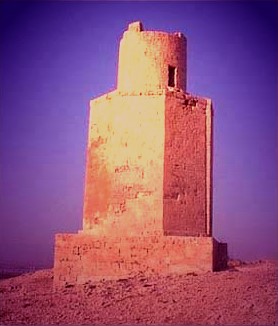
The team, led by Dr. Kathleen Martinez, began excavations in Taposiris Magna five years ago in an attempt to locate the tomb of the well-known lovers, Queen Cleopatra VII and Mark Antony. There is some evidence that suggests that Egypt's last Queen might not be buried inside the tomb built beside her royal palace, which is now under the eastern harbour of Alexandria.
The archaeologists have been exploring the underground labyrinth, turning up a bronze statue of the goddess Aphrodite, the alabaster head of a Cleopatra statue, a mask believed to belong to Marcus Antonius and a headless statue from the Ptolemaic era.
The location is of great interest to those of us who love Antinous because it is very likely that Hadrian and Antinous visited this temple site in the final summer of the brief life of Antinous.
As we know, the imperial entourage was visiting Alexandria in the summer of the year 130, and we know that Hadrian and Antinous hunted and killed a man-eating lion which had been terrorizing the countryside. It was described as a "Libyan" lion, "Libya" being the term used in those days for everything west of Alexandria.
So it is highly possible (even likely) that the imperial hunting party passed by the temple at Taposiris Magna, which is less than 45 kms (30 miles) west of Alexandria. In the year 130 it was a vast complex of temples that included a Roman fortress. The name Taposiris comes from the legend that one of the relics of Osiris was enshrined there.
This is a very noteworthy site because it is the location of the only wholly Greek style temple (with columns) ever known to have been built in Egypt. And it is also a temple which was converted into a military fortress by the Romans.
In addition, it is the location of a unique stone tower overlooking the sea which is believed to have been a miniature replica of the Great Lighthouse at nearby Alexandria.
Only shattered walls and foundations are left to indicate the size of Taposiris Magna.
It is entirely conceivable that Cleopatra and Marcus Antonius, cornered by Octavian's advancing forces, might have sought refuge at this fortified temple complex with its tower suitable for use as an observation post. It is also entirely possible that Cleopatra and Antonius were buried here.
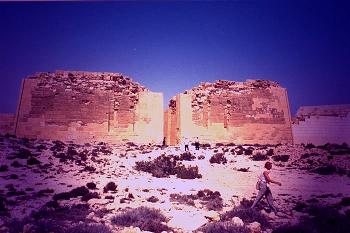
An even more intriguing possibility is that the Lost Tomb of Alexander the Great might be located here. His rock-crystal sarcophagus was variously located in ancient Memphis and Alexandria, but no one knows where it might be today. Is it possible that Hadrian and Antinous stopped at Taposiris Magna to take a look at Alexander resting in his crystal coffin?
The reported system of tunnels and catacombs under the temple complex is not surprising. It was commonplace for treasures to be buried in chambers under Egyptian temples. Sacred statues would be "deconsecratred" and entombed under the paving stones of temple floors in order to make way for new statues — otherwise the temples would be overflowing within a few generations. Hundreds of such "retired" statues have been found under the Temple of Amun at Karnak.
The practice continued into Christianity, which is why many old churches have crypts in which sacred items (and important people) are buried so as to be in sacred consecrated soil.
This possibility might also be a clue to the Lost Tomb of Antinous. Perhaps he is buried in a chamber below the Great Temple of Antinoopolis or else under the Divine Hadrian's Villa, or possibly in a vault under Hadrian's Mausoleum.
Behind the Taposiris temple, a necropolis has been discovered containing many Greco-Roman style mummies. Early investigations, said Dr. Hawass, show that the mummies were buried with their faces turned towards the temple, which means it is likely the temple contained the burial of a significant royal personality, possibly Cleopatra VII.
If Hawass is right, he could make the greatest archeological discovery in Egypt since Tutankhamun's tomb was uncovered by the British archeologist Howard Carter in 1922.
Dr. Hawass has already hailed the dig as a success, whatever the outcome: "If we discover the tomb ... it will be the most important discovery of the 21st Century. If we do not discover the tomb ... we made major discoveries here, inside the temple and outside the temple."
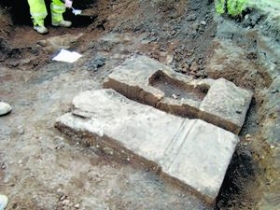
Archaeologists in Scotland are studying inscriptions on two Hadrian-era Roman altar stones which were unearthed by construction workers near Edinburgh.
The stones in the village of Musselburgh, in the Edinburgh suburb of Inveresk, have been described as the most significant find of their kind in the past 100 years, according to a BBC NEWS report.
The discovery was made during renovation work at a cricket pavilion. Construction at the structure, which houses grandstands and dressing rooms for players, was suspended temporarily while experts examined, photographed and retrieved the stones. A photo (left) was published in the East Lothian Courier newspaper
"The stones have carvings and quite possibly inscriptions which can have a wealth of information on them, a lot of data about the people and their religion at that time," said George Findlater, senior inspector of ancient monuments at Historic Scotland.
At least one if not both of the altars is from the 2nd Century and is dedicated to the Roman God Jupiter, according to the BBC.
A spokesperson for Historic Scotland said: "Inveresk is one of the most important Roman sites in Scotland, containing a large Roman fort and a civil settlement with a bathhouse and amphitheatre. The discovery of two almost intact carved Roman altars ... is the most significant find of its type in the last 100 years of investigation and discoveries at Inveresk."
Inveresk is 100 kms (60 miles) north of Hadrian's Wall, so experts say the stones will be invaluable in providing clues to frontier life beyond the northernmost border of the Roman Empire.
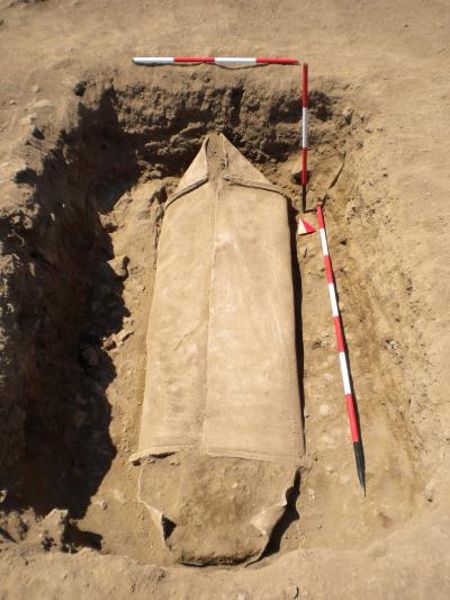
A mysterious, 1,800-year-old lead coffin weighing half a ton — bizarrely folded over its ancient corpse like a "burrito" — has been unearthed by American archaeologists working at a vast dig site east of the city of Rome, and only a short distance from Hadrian's Villa.
The highly unusual object — which is still sealed — is to be delivered to the American University in Rome, where scientists will use a variety of techniques to determine what may be inside, PhysOrg reports.
The sheer lavishness of the size of the coffin spawned speculation that it might contain the remains of a highly respected personage from the time of the Antonine Emperors in the 2nd Century — possibly a gladiator or other prominent person.
The strange oblong box, weighing 350 kilos (1,000 pounds), was found at the site of the ancient city of Gabii, just 10 kms (6 miles) from Hadrian's Villa at Tivoli. Hadrian was a notable benefactor of ancient Gabii, showering the city with gifts and monuments, such as a a senate-house (Curia Aelia Augusta) and an aqueduct.
It is too early to say whether the mysterious casket could be from the LOST TOMB OF ANTINOUS, though the unusual design and proximity to the Divine Hadrian's beloved home have prompted speculation that it must be the resting place of a very prominent contemporary of his. However, no one knows whether the large box-like container will reveal a body or possibly some sort of treasure.
But University of Michigan professor of classical studies Nicola Terrenato, the leader of the dig site, says that whatever is inside the sarcophagus will certainly be a surprise to archaeologists.
"We're very excited about this find. Romans as a rule were not buried in coffins to begin with and when they did use coffins, they were mostly wooden. There are only a handful of other examples from Italy of lead coffins from this age — the 2nd, 3rd or 4th Century AD. We know of virtually no others in this region," says Terrenato.
Speaking about the coffin itself, the expert adds that it resembles a Mexican "burrito". She says, "It's a sheet of lead folded onto itself an inch thick. A thousand pounds of metal is an enormous amount of wealth in this era. To waste so much of it in a burial is pretty unusual."
There are many possibilities as to who or what may be buried inside, if indeed it turns out to contain anything. The team says that it could be a famous gladiator, a high-profile personality or early Christian bishop.
"It's hard to predict what's inside, because it's the only example of its kind in the area. I'm trying to keep my hopes within reason," the scientist adds. Terrenato concludes by saying that, if the imaging techniques the team has planned do not penetrate the lead sheilding, experts will have to deliver the half-a-ton casket to a medical facility for MRI scanning.
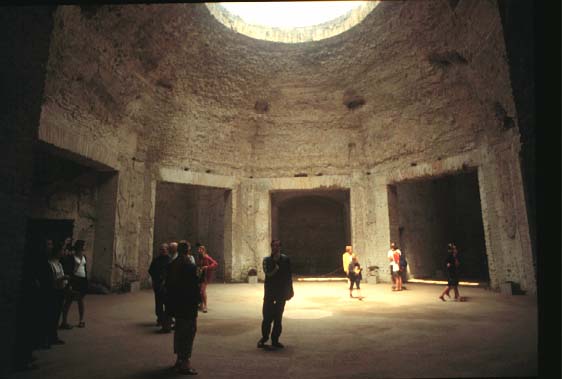
A portion of the ceiling of Roman emperor Nero's famed Domus Aurea (Golden Palace) collapsed under the weight of rain-sodden soil on Tuesday.
No one was injured in the incident, which happened when the ceiling which topped one of the corridors that links the many halls and chambers of the sprawling archaeological complex, caved in with a deafening roar.
Officials said rain water had collected on a lawn above the ceiling, causing excessive pressure on the corridor beneath, which lies partly underground.
Rome Mayor Gianni Alemanno said he was "very concerned" about the fragile nature of Rome's ancient sites, and that an investigation would take place to determine the exact cause of the collapse and ways to prevent future such disasters.
The site, which is situated in central Rome not far from the Colosseum, was cordoned off as sand bags were placed to support the remaining parts of the corridor's walls. The corridor whose ceiling collapsed is one of the ones pictured above left which branches off from a central court.
"Restoration work must begin immediately," to prevent more parts of the structure from collapsing," Domus Aurea site superintendent Luciano Marchetti said.
The collapse should "serve as an alarm", as more financing for the site's upkeep is urgently required, Marchetti added.
Built by Nero in the First Century AD as a lavish landscaped villa, the Domus Aurea, has partially become covered by top soil over the centuries, making it vulnerable to water seepage.
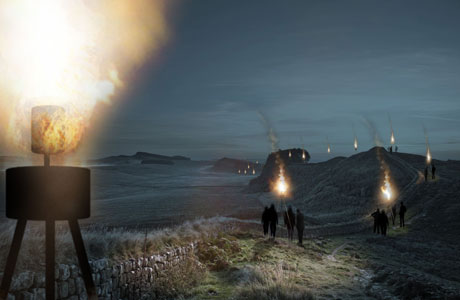
"They came, they saw and they clambered on the ramparts -- in numbers not seen on Hadrian's Wall since the Romans called it a day and pulled out their legions 1,600 years ago," The Guardian reports today following the weekend nighttime "Illumination" of Hadrian's Wall from coast-to-coast across northern Britain.
As night fell, a group of 500 volunteers holding gas-powered beacons and standing 250 meters apart created a 30-minute "Line of Light" in a spectacle to mark the 1,600th anniversary of the end of Roman rule in Britain.
The event, which was visible from space, recreated the lights that once shone from the imposing Roman turrets and mini-castles which were regularly stationed along the length of the wall.
The ceremony began at Segedunum Roman Fort at Wallsend in northeast England, and the line of lights then made its journey westwards, passing through the cities of Newcastle and Carlisle and taking in some of the some of England's most picturesque countryside.
The final beacon was lit at Bowness-on-Solway on the Cumbrian coast.
The event marked British Tourism Week and the 1600th anniversary of the Roman departure from Britain in 410 AD.
Thousands of people applied to take part in the rare event and viewing areas along the central line of the wall sold out months earlier.
Hadrian's Wall Heritage chief executive Linda Tuttiett told London's Daily Mail people from across the world travelled to the site for the one-time event.
"When you see you the lights here, it's easy to imagine what it must have been like to be stationed here up on the wall," she told The Mail.
"With Hadrian's Wall being one of the most important sites in the country, we thought it would be a brilliant opportunity for us to showcase our stunning heritage. We've been delighted by how much enthusiasm this event has generated."
Hadrian's Wall was built in 122 AD on the orders of the Divine Hadrian to mark his empire's northern frontier.
It remained in use until the early 5th Century AD when, with the empire collapsing and the city of Rome itself under threat, the Romans left British shores.
It is the largest monument from the ancient era in northern Europe and is a UNESCO World Heritage Site.

Archaeologists in Egypt have unearthed what appears to have been a major temple to the cat goddess Bastet in the royal quarter of ancient Alexandria.
The discovery represents the first trace of the true location of Alexandria's royal quarter, where the Ptolemies resided and which served as the home base for Roman visitors, such as Julius Caesar and Marcus Antonius, and later Emperor Hadrian and his lover Antinous in 130 AD.
Zahi Hawass, head of the Egyptian Supreme Council of Antiquities, says the temple was in use for centuries. Presumably it was still in use when Hadrian and Antinous arrived in Alexandria. He says in later centuries Christians and Moslems used it as a "quarry" for stone to build new structures.
Its ruins remained buried until an archaeological team, doing routine excavations near the Roman theatre in Alexandria, stumbled onto the temple foundations and a cache of 600 Ptolemaic statues, primarily of cats and the goddess Bastet.
The temple was built by Queen Berenike, wife of Ptolemy III (246-222 BC). The temple compound is believed to measure 60 metres by 15 metres and extends underneath the present Ismail Fahmi Street in the heart of Alexandria.
Mohamed Abdel-Maqsoud, head of the antiquities of Lower Egypt, said the team, which comprises 18 skilled excavators and restorers, unearthed a large collection of statues depicting the cat goddess Bastet, the goddess of protection and motherhood, which confirms that the temple was dedicated to this popular Delta goddess.
The Bastet statues were unearthed in three different areas of the site together with other limestone statues of unidentified women and children, according to Al Ahram newspaper. Clay pots as well as bronze and faience statues of various ancient Egyptian deities have also been uncovered, along with terracotta statues of the gods Harpocrates and Ptah.
Initial on-site findings, Abdel-Maqsoud says, reveal that the temple foundations definitely can be dated to the reign of Queen Berenike, making this the first Ptolemaic temple discovered in Alexandria to be dedicated to the goddess Bastet. It also indicates that the worship of the goddess Bastet continued in Egypt after the decline of the ancient Egyptian dynasties.
An inscribed base of a granite statue from the reign of Ptolemy IV was also unearthed. It bears an Ancient Greek inscription written in nine lines stating that the statue was commissioned by an official of high standing at the Ptolemaic court. Abdel-Maqsoud believes the inscription celebrates Egypt's victory over the Greeks during the Battle of Raphia in 217 BC.
Archaeologists also found a cluster of other ancient structures, including a Roman water cistern, a group of 14-metre-deep water wells, stone water channels, and the remains of a bath area, as well as a large number of clay pots and shards that can be dated as far back as the founding days of Alexandria in the 4th Century BC.
"This find is the first trace of the real location of Alexandria's royal quarter," Abdel-Maqsoud told the newspaper.
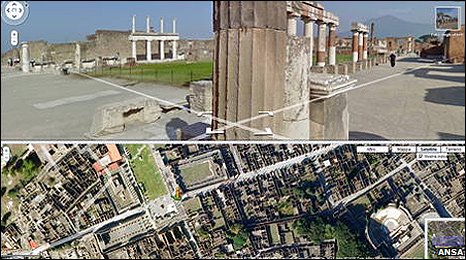
Now you can take a tour of Pompeii without leaving your home thanks to a new Google Street View application which enables internet users to take a 360-degree street-level VIRTUAL TOUR OF THE ANCIENT ROMAN CITY OF POMPEII.
Italy's culture ministry says it hopes the move will boost tourism to the site, according to ANSA, the Italian state news agency.
Among the ruins visible on the search engine's free mapping service are the town's statues, temples and theaters.
The city was buried in ash after Mount Vesuvius erupted in 79 AD and was not discovered until the 18th Century. The volcanic debris preserved many of the city's buildings, frescos, silverware, mosaics and other artefacts.
"Giving people a chance to take a virtual stroll through Pompeii will give an extraordinary boost to Italian tourism," Mario Resca of the culture ministry's heritage promotion department told ANSA.
The Google Maps service, launched in 2007, provides panoramic street-level views of more than 100 cities around the world. Up until now Google has primarily focused its 360-degree panoramic service on major modern cities around the world such as New York, San Francisco, or Rome. But it also includes the ancient heritage site of Stonehenge and the historic center of Prague.
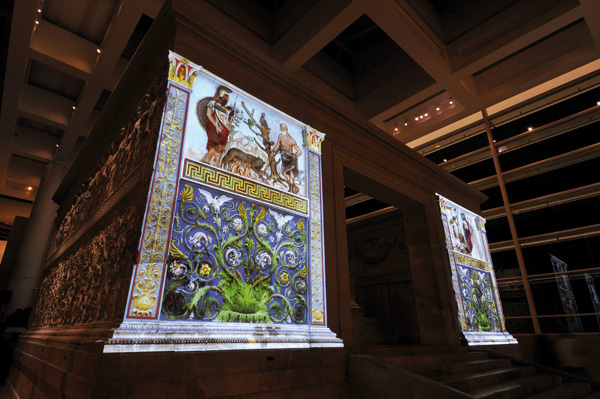
Augustus Caesar's Ara Pacis, the "Altar to Peace" built exactly 2,000 years ago, showed its true colors on Sunday thanks to a groundbreaking lighting projection system.
Though the white-marble monument has lost its color over the centuries, visitors were able to see its intricate array of friezes in dazzling color. According to researchers from the Vatican museums, who have gone over every inch of the altar for traces of pigment, the Ara Pacis was brightly colored when unveiled by the Roman Senate in the year 9 AD -- 2,000 years ago.
Rome's culture chief Umberto Broccoli told Italy's ANSA news agency that the study furnished lighting technicians with the exact colors which originally embellished the monument, which they replicated with hundreds of tiny lighting projectors.
Broccoli said the color system, financed in part by a Roman supermarket chain, cost the city about $100,000, "but it was money well spent".
"The color reproduction is extraordinary," Broccoli told ANSA. "If Augustus were to see it, he wouldn't notice any difference".
This is not the first time that the Ara Pacis has been "painted". A rather less sophisticated system was tried out during Emperor Augustus' birthday in September 2008, but museum officials say the technology has come a long way in past year. Visitors Sunday evening clearly were stunned by the spectacular altar.
And their reaction was understandable. The famed West Facade and East Facade were both illuminated. The West Facade (above left) is highlighted by a frieze called "The Lupercal Panel" which shows Romulus and Remus (suckled by the She-Wolf) being discovered by Faustulus the shepherd while Mars looks on. The God of War is resplendent in a crimson cloak which contrasts with deep greens of the lower frieze's viney motif.
On the left panel of the East Facade (below right), a goddess nurses the twins Romulus and Remus and, on the right-hand panel (below), Trojan hero Aeneas makes a sacrifice to the gods, all in the life-like splendor they enjoyed under the paint brushes of Roman craftsman.
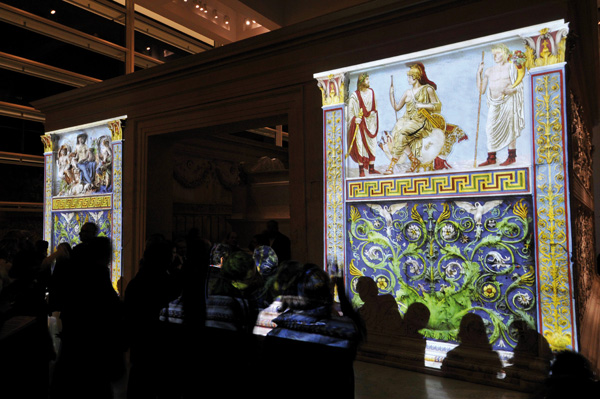
Scholars have suggested that the goddess variously might be Italia, Tellus (Earth), Venus, or Peace. The Goddess of Peace (Pax Augusta) makes the most sense since the entire scene depicts the benefits of peace, and the monument is the "Altar of Augustan Peace", not the "Altar of Italy" or "the Altar of Earth". The exact identity of the goddess, however, remains in dispute.
The Altar marks the northern city limits. Travelers approaching Rome upon arrival at the port of Ostia would have seen the Altar on the west side of the Via Flaminia, the backdrop of which was the Seven Hills of Rome ? the "skyline" of Rome.
The Ara Pacis Augustae stood in the flood plain of the river Tiber, where it became buried under silt over the centuries. It was rediscovered in modern times and, after decades of on-again, off-again excavation, was finally fully restored under the rule of Benito Mussolini.
Alas, the colored light show was only temporary. Visitors hoping to see the color-illuminated Ara Pacis will have to wait for another special occasion, perhaps on April 21, the annual celebration of the founding of Rome.
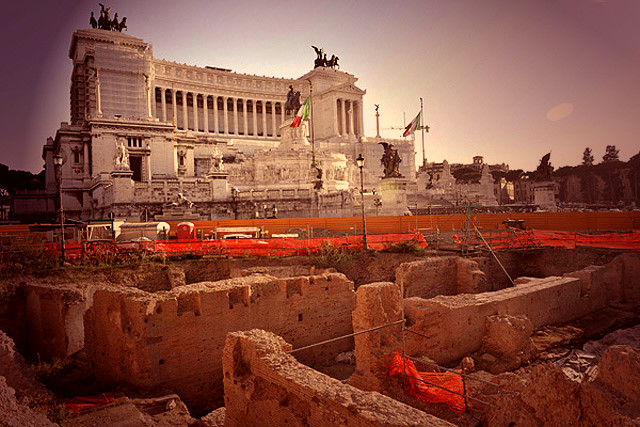
Archaeologists in Rome have discovered ruins of what they believe may have been the first university west of Athens -- Emperor Hadrian's Athenaeum, modeled on the original school in Athens.
The ruins were unearthed by archaeologists excavating at the Piazza Venezia, just across the street from the colossal Victor Emmanuel Monument. The excavations are part of an exploratory dig to determine where and how a third subway line might run through the city of Rome.
The location comes as something of a surprise since Hadrian's Athenaeum traditionally was believed to have been located on the Capitoline Hill. The ruins are located below the hill on the fringes of the Forum.
The experts say they are convinced this must be the site of the Athenaeum because the ruins appear to be those of a large auditorium-style lecture hall which could have accommodated 200 students.
They uncovered twin monumental staircases of six steps each which were buried under debris that was the result of the collapse of upper floors of the building, probably during an earthquake in the Middle Ages.
Each of the staircases -- with wide, shallow, deep steps -- are on opposite ends of a rectangular room with granite and yellow marble paving. Experts believe the "stairs" were actually lecture hall seating.
Little is known of the details of study at the Athenaeum, but some literary sources suggest that young men from all parts of the Roman Empire, after finishing their usual school and college studies in their own town or province, came to Rome for higher education.
According to the 1875 Dictionary of Greek and Roman Antiquities by John Murray, the Athenaeum was founded by the Emperor Hadrian at Rome in 133 AD, three years after the death of Antinous. Hadrian had returned to Rome a broken man nearing 60, and set about building monuments for posterity and making arrangements for his successor.
In keeping with his dream of creating an empire based on Hellenistic principles of beauty, tolerance and learning, he established the Athenaeum for the promotion of Classical Liberal Arts studies. It set the standards for subsequent schools of higher learning in Western Europe. Royston Lambert, in his biography of Antinous Beloved and God calls the Athenaeum "the first university in the West."
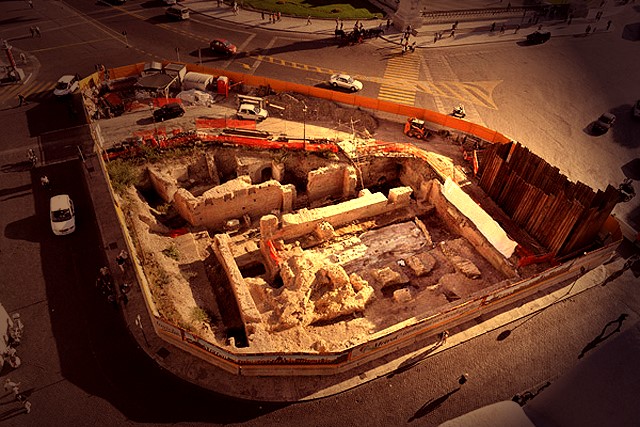
It was the premier institution of higher learning in the world for at least the next three centuries. Murray writes that, as late as the early 5th century AD under the reign of Theodosius II, records show that there were three orators, ten grammarians, five sophists, one philosopher and two lawyers on the faculty.
Besides the instruction given by full-time faculty members, guest lecturers included poets, philosophers and orators who declaimed and recited their compositions.
The new Metro C line will run east to west through the very heart of what used to be ancient Rome. Although the actual tunnels for the Metro are not a problem ? they will be dug 30 meters (100 feet) down, well beneath any archaeological treasures ? the stations, exits and air ducts present major problems in many locations.
Archaeologists are trying to pinpoint the areas on downtown thoroughfares and squares where the least damage will be done.
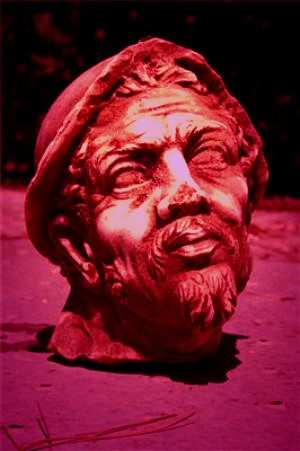
British archaeologists working at the site of an ancient port city on the mouth of the Tiber have unearthed the ruins of a highly-unusual amphitheater-shaped structure the size of the Pantheon which may have been a luxurious private gladiatorial arena for Emperors Trajan and Hadrian, according to UK news media.
The find was made at the site of Portus, the major cargo port during the Imperial era. Trajan greatly enlarged Portus, so that it rivaled the age-old nearby port of Ostia.
The strange structure was first discovered in the 1860s, when it was thought to be a "theater." Then all trace of it vanished under sediment. The excavation team from the University of Southampton, working in collaboration with the British School at Rome, has been conducting the first ever large-scale dig at Portus on the banks of a hexagonal shaped man-made lake which formed the 2nd Century harbor.
"When the site was visited by archaeologist Rodolfo Lanciani in the 1860s he marked on his plans the remains of a theater, but subsequently no trace of the building could be found," says Professor Simon Keay, Portus Project Director and leading expert in Roman Archaeology at the University of Southampton.
"Our team has rediscovered this 'theater' and proved it was in fact a building more akin to an amphitheater. Lanciani had only found half of the structure, leading him to misinterpret its shape and function," news reports quote him as saying.
In the 2nd Century AD, during the reigns of Trajan and Hadrian, Portus was a gateway to the Mediterranean. But due to silting, the sprawling site now lies two miles inland, close to the runway at Fiumicino airport.
Today it sits incongruously next to the airport runway and the team digs to the sound of jet engines on land owned by Duke Sforza Cesarini - from one of Italy's oldest noble families - and the Italian government, according to the British PA news service. The project concentrated on the banks of a hexagonal-shaped man-made lake which formed part of the 2nd Century harbor, about 35 kms (20 miles) from the Italian capital, and found the amphitheater inside a gigantic imperial-style palace, the PA report says.
Keay is quoted as sayiing he thinks the splendid material used to build the amphitheater means it could have been a private playground for the Antonines, the famous Roman emperors in the 2nd Century.
Keay says, "This amphitheatre is, in fact, tucked away. It's at the eastern end of the palace and it's a very intimate building and you would not even know it was there unless you approached from the east.

"Its design, using luxurious materials and substantial colonnades, suggests it was used by a high status official, possibly even the emperor himself, and the activities that took place there were strictly private: it could have been games or gladiatorial combat, wild beast baiting or the staging of mock sea battles, but we really do not know. What we do know is it's unusual to find this type of building with elements of imperial architecture so close to a harbor," British press reports quote him as saying.
But he cautions that it might not have been used as an arena at all.
"It may have been a form of Roman 'folly', shaped like an amphitheatre, but used as a monumental garden," he says.
The experts are also puzzled by a white marble head of a statue unearthed at the site of once-luxurious rooms close to the "amphitheatre". The image above is courtesy of University of Southampton. It is thought the head dates back to the time of Trajan and Hadrian.
"The elderly bearded male wearing a flat skull-cap could suggest it is Ulysses, however it is equally possible it is a representation of one of the Greek sailors who accompanied him on his travels. For the moment his identity remains a mystery," concludes Professor Keay.
Research has been underway at Portus for several years and Professor Keay hopes to continue working there. "This is one of the most important archaeological sites in the world," he says.
"Certainly it should be rated alongside such wonders as Stonehenge and Angkor Wat in Cambodia. So much of this Imperial port has been preserved and there is much more to learn about its role in supplying Rome and in the broader economic development of the Roman Mediterranean," he told Alpha Galileo, the online European research news service.

Archaeologists in Italy have unearthed the circular banquet hall at Emperor Nero's lavish "Golden House" which had a fabled "rotating ceiling" simulating the movements of the stars and planets.
The Golden House (Domus Aurea) was a party villa, as shown by the presence of 300 rooms without any sleeping quarter. Nero's own palace remained on the Quirinal Hill. Strangely, no kitchens or latrines have been discovered yet.
The discovery of the circular banqueting hall climaxes a four-year dig at the sprawling site in the middle of modern-day Rome.
"This discovery has no equal among ancient Roman architectural finds," chief archaeologist Maria Antonietta Tomei said in announcing the find, according to ANSA, the Italian news agency.
She said that the team of archaeologists think the dining room could be up to 60 meters long (200 feet), but have so far uncovered only a few supporting stone pillars, one of which is 4 meters (15 feet) in diameter in the center of a circular masonry perimeter wall.
After two-thirds of Rome was destroyed by the great fire in 64 AD, Nero used fire-ravaged land between the Esquiline and Palatine Hills as the site for his new palace. It was not so much a palace as a series of buildings scattered over a landscaped "countryside in the city" (rus in urbe) which included an artificial lake.
The main building was extravagantly crafted, and boasted rooms and hallways decorated almost entirely in gold, with marble and ivory encrusted ornamentation.
The architects in charge of the project, Severus and Celer, designed two of the principal dining rooms to flank an octagonal court, surmounted by a dome with a giant central oculus to let in light. It was a design element which Emperor Hadrian would expand upon in his design for the Pantheon.
The Domus Aurea had more than one banqueting hall, according to the Ancient Roman historian Suetonius. But the most extravagant one was a vast circular room which featured a "rotating ceiling."
Celer and Severus devised an ingenious mechanism, either cranked by slaves or perhaps powered by flowing water, which made the ceiling within the dome of the main banqueting hall rotate like the heavens, while perfume was sprayed and rose petals were dropped on the assembled diners. The rotating ceiling was painted with the stars and the planets by the artist Fabullus.
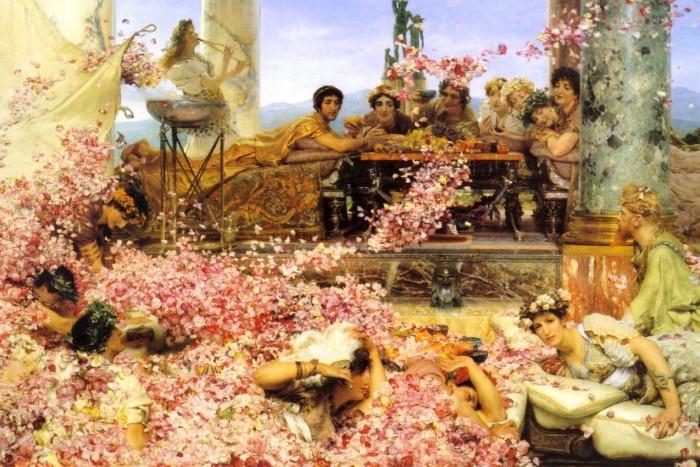
According to some accounts, perhaps embellished by Nero's political enemies, on one occasion such quantities of rose petals were dropped that one unlucky guest was asphyxiated -- a similar story is told of the Emperor Elagabalus.
In his book De Vita Caesarum ("The Lives of the Caesars", best known in English as "The Twelve Caesars"), Suetonius describes the banqueting hall in detail:
"The main banqueting room was circular, and its ceiling rotated slowly, day and night, in time with the heavens."
Suetonius goes on to write that when the lavish Domus Aurea was finally completed, Nero said, "Good, now I can at last begin to live like a human being!"
However, Nero did not enjoy the frescoed halls and gold-encrusted ceilings for too long. It was completed in AD 68 -- the year he committed suicide amid a revolt.
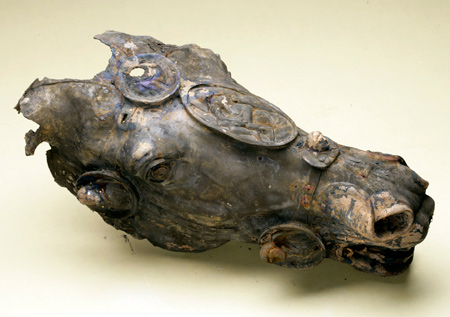
Archaeologists have unveiled stunning pieces of a gilded bronze equestrian statue of Augustus Caesar on horseback which once adorned the central square of a Roman "frontier" town deep inside Germanic tribal territory.
The largest piece is a nearly intact life-size head of a horse cast in bronze and originally gold-plated. Some of the gilding is still visible in the photo (left) issued by the German Archaeological Institute's Roman-Germanic Commission.
The head is richly detailed with an ornate bridal studded with medallions in honor of Mars, Nike and Jupiter. Smaller pieces found nearby indicate the bronze horse supported an Imperial rider, most likely Augustus.
The statue was the focal point of a town more than 160 kms (100 miles) deep inside Germanic territory which was a staging point for Roman expeditions aimed at colonizing and civilizing the region they dubbed Germania Magna (Greater Germany).
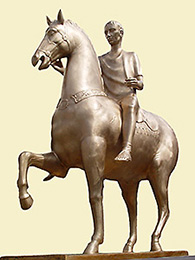
Experts who have been working at the site for 15 years have long believed that a great statue of Augustus on horseback was located in the strategic town, far east of the Rhine and north of the Danube. The town sported marble-clad temples and was a major trading post, according to pottery sherds and coins which have been found, dating from 5 BC to 9 AD, the year of Battle of Teutoburg Forest.
It was in 9 AD that Germanic forces under Arminius annihilated three Roman legions led by Publius Quinctilius Varus. The crushing defeat left Roman cities to the west in Gaul totally undefended. Augustus dropped his plans for colonizing Across-the-Rhine Germany, forever changing the course of European history.
The dig site is about 100 kms (80 miles) south of Teutoburg Forest. The gilded-bronze horse head was found at the bottom of the town's central well, leading experts to believe that triumphant Germanic warriors captured the town and pulled down the statue. In keeping with Germanic religious rites, the horse's head was ritually "drowned" in the well so as to appease the totemic cult of the horse. The rest of the statue was smashed to bits.
Presumably, the Romans would have removed the splendid statue and transported it back across the Rhine, had they been able to do so. The shattered remnants are seen as proof of sudden chaos after the Teutoburg Forest military disaster.
The sprawling site, near the modern village of Waldgirmes, indicates that the Romans had planned for this town to grow into a major civitas administrative center. But it was left unfinished by the Romans, who used it only as a staging base for punitive expeditions and evacuation of Roman civilians after 9 AD, according to the German archaeologists. The finds suggest that this was intentional: between AD 9 and 16, during the period of Roman punitive expeditions, the site was occasionally used as a military camp. After that, it was destroyed either by the retreating Romans, or by the advancing Germanic hordes.

Hadrian's Wall started out as a hastily-erected wooden-log stockade fence, according to a British archaeologist.
The timber fence could have been up and standing in less than six months, allowing engineers to work on the stone-and-turf wall behind it in total security, according to structural archaeologist Geoff Carter.
Carter's theory is spelled out in detail in a 60,000-word monograph at his Theoretical Structural Archaeology online website.
Carter has become a specialist over the years in structural archaeology and, in particular, post holes ? quite literally, the holes left in the ground by wooden posts.
"Archaeologists spend a surprising amount of time watching men digging holes in the road, it's often 'routine', but just occasionally it really pays off," Carter writes.
His observations of modern techniques guided his insights into rows of mysterious holes a few meters north of Hadrian's Wall which have always puzzled other archaeologists.
For some time now, archaeologists have known about three mysterious lines of post holes running in front of Hadrian's Wall, he says. It has been assumed that they originally held nothing more than pointed sticks that provided another obstacle to attack.
Mysteriously, however, the rows of post holes do not exactly follow the line of the stone wall, veering inwards and outwards at odd intervals, at times nearly touching the foundations of the wall. No one had an explanation for that ? until now. Carter says he has found compelling proof that the post holes are what is left of a temporary timber fence which was built BEFORE the stone wall was erected.
"I demonstrate that these thousands of post holes, six posts every meter (4 feet), are the foundation of massive timber ramparts 3 meters wide (10 feet), about 6 meters tall (20 feet), and quite probably stretching all 117 kms from coast to coast," he says.
"The temporary timber wall joined the turrets together during the six years it took to build the stone wall behind it.
"This explains why the ditch is so far from the Wall, and why it respects the postholes of the timber wall and curves in towards the turrets."
He estimates over 2.5 million trees would have been used in the construction ? making it one of the largest timber structures ever built ? only to be dismantled when the Hadrian?s Wall we know today was completed.Carter bases his estimates on the historical account given by Julius Caesar himself in his in his book about the Gallic Wars, Commentarii de Bello Gallico, in which he described fortifications made during the siege of of Al?sia, a hillfort in France where the Gaulish leader Vercongeterix was holed up with most of his army.
Caesar wrote that a series of timber walls was built in just three weeks, covering a distance of 13 kms.
Carter says that, on that basis, it could have taken as little as 20 weeks to build the wooden Hadrian?s Wall from coast to coast.
"Of course it wasn't that simple, but the Roman army was good at this sort of thing. It's what they did for a living and to some extent their lives depended on it," he writes. "Creating the 117 kms corridor was probably achievable within a year."
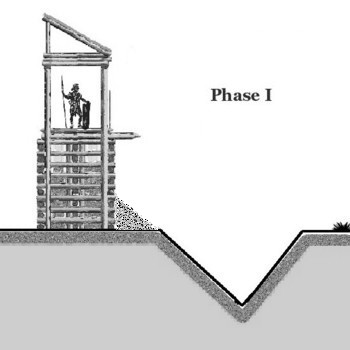
Another important source of information on Roman military engineering is Trajan's column in Rome, which depicts his two victorious campaigns against Dacians. One scene shows a ballista set on a structure made from layers of logs laid at right angles to each other, while another shows legionaries cutting and extracting timber baulks.
Roman engineers were masters at building such temporary fortifications, which were then dismantled.
"When, after the probable six years or so, the Wall was complete, the timber wall, probably one of the largest wooden structures ever created, was dismantled, probably section by section, as the wall was completed," Carter explains.
"Its timbers almost certainly were recycled into the dozens of new forts, and, into the new stone wall, - it should not be forgotten, that without addition timber works, a simple wall and parapet, while impressive, was not a particularly defendable structure, (especially when your ditch is so far away).
"So this enormous structure disappeared leaving only post holes, which, as so often happens, could have been easily overlooked, which would have been a shame, and rather a waste of about 2.5 million trees," he adds.
With tongue firmly planted in cheek, Carter concludes by saying that a humble hole in the ground can provide priceless historical insights to the trained eye.
"Post holes, although often little regarded, are the key to understanding much of the archaeological built environment, and it?s best not to ignore them, or explain them away ? they may be filled voids now, but they are called post holes because they once held posts, and THEREIN LIES THEIR UTILITY ? as Lao Tzu might have said."
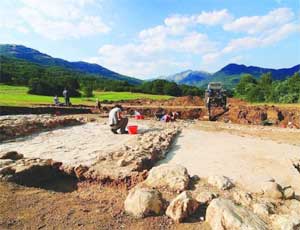
Archaeologists in Italy have uncovered the foundations of a sprawling villa nestled in the Apennines northeast of Rome which some experts immediately identified as Emperor Vespasian's birthplace.
Other archaeologists were skeptical, noting that four years of excavations have failed to produce any shred of positive evidence that would indicate any link to Vespasian.
Unfazed by doubters, Professor Filippo Coarelli, who heads the dig, told La Stampa newspaper he is convinced the villa was where Vespasian was born.
At a news conference, he played up the fact that 2009 is the 2,000th anniversary of the birth of Vespasian. La Stampa published a photo of the dig site (left).
Coarelli bases his claim on circumstantial evidence that Vespasian was born nearby in the village of Falacrine, 80 kms (50 miles) northeast of Rome.
The location of the village was found in 2005, and archaeologists from Italy, the UK and France have been working there ever since.
The villa sprawls over 14,000 square metres (150,000 square feet), and its lavish mosaic flooring and ornate column bases indicate it was built in the 1st Century AD. Professor Coarelli told La Stampa it was obviously the splendid home of a family of means. However, he conceded it might have belonged to a close friend or relative of the emperor's, rather than to Vespasian himself.
"Villas from this era do not generally have inscriptions, which complicates the identification of their owners," he told the paper.
Whether in this house or elsewhere, Vespasian was born at or near Falacrine on November 17th of the year 9 AD. He was one of four generals who vied for power after Nero was deposed, eventually emerging from the fray as sole ruler on July 1st of the year 69. His throne name was Imperator Titus Flavius Vespasianus Caesar.
His lasting claim to fame was construction of the Colosseum in Rome. He established the short-lived Flavian Dynasty which included his sons Titus and Domitian. He died June 23rd in the year 79 AD of what was diagnosed as "rampant incurable diarrhea".
Suetonius writes that Vespasian was indignant over the humiliation of having to conduct official business from the toilet seat and that his final recorded words were: "An emperor should die standing up!"
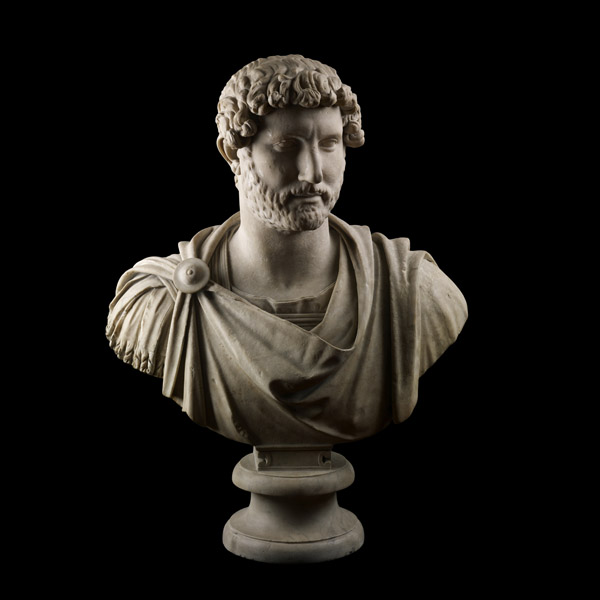
Following the success of last year's Face of an Emperor exhibition, Segedunum Roman Fort in northern England is once again welcoming the Emperor Hadrian, this time in the form of a stunning marble bust, on show at the museum from August 14 to October 4.
The touring exhibition from the British Museum is entitled View of an Emperor: Hadrian's Marble Portrait and features a marble bust found at the Villa Adriana, Hadrian's magnificent country residence near Tivoli outside Rome, according to a report in the North Tyneside News Guardian newspaper.
This particular sculpted portrait of Hadrian shows a remarkably naturalistic detail -- a deep, diagonal crease in both earlobes which may be a tell-tale clue to the cause of the emperor's death in the year 138 AD.
We now know there is a strong link between these creases and coronary artery disease. The earlobe creases are caused by the collapse of blood vessels in the earlobe, one of the early symptoms of the disease. It is impossible to say if Hadrian suffered from this illness, but the existence of such a life-like element in this bust offers an intriguing clue.
View of an Emperor coincides with the 13th decennial Hadrian's Wall Pilgrimage. Before arriving at Segedunum, the marble bust will be on display at Tullie House as the pilgrims pass through Carlisle. It will then move to Segedunum to greet the pilgrims when they arrive at the Wall's end on Friday 14 August, according to the report in the News Guardian.
The marble bust will be on display throughout the 21st International Limes (Roman Frontiers) Congress, which takes place in Newcastle from Monday 17 to Sunday 23 August. More than 300 experts on Ancient Rome from around the world are converging on Newcastle University for the congress.
The Limes Congresses, held since 1949, are the main international forum for exchanging ideas and information on the development of Roman frontiers. Papers to be presented at this year's Limes Congress cover themes ranging from women and families in the Roman army to the study of Roman frontiers in a globalized world, said the report in the News Guardian.
On Friday, August 21, the Congress will be open to the public for a session entitled Presenting the Roman Frontiers ? Communicating the Evidence. The session will explore how evidence and narratives about the Roman Frontiers are communicated to the public, and will examine how this can be done in a way that challenges and engages visitors.
In particular it will explore how the Romans are presented through the written word, the arts, film and television and museums.
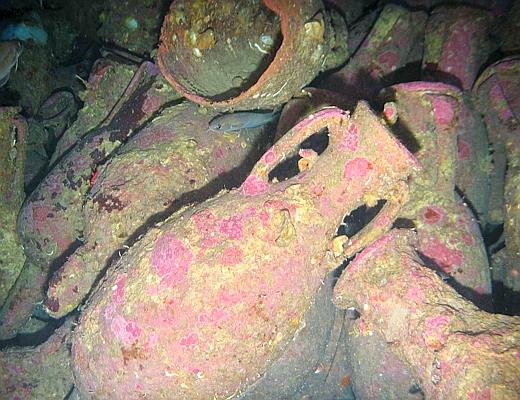
Using state-of-the-art submersible probes and sonar, underwater archaeologists have discovered the wrecks of five Ancient Roman cargo vessels off the coast of Italy which date to the era of the Antonine Emperors, including Hadrian and his heirs.
Incredibly, the vessels were found to be largely intact, with their cargoes of wine, olive oil, fish sauce and other goods arranged in tidy rows of amphorae jars, Italy's Ministry of Culture announced at a news conference.
The ministry released photos showing amphorae (left) neatly stacked just as they were when the vessels sailed for Rome 1,800 years ago.
The shipwreck site is near the infamous banishment island of Ventotene in the Tyrrhenian Sea between Rome and Naples. Ventotene is where Augustus banished his adulterous daughter Julia the Elder.
Tiberius, Claudius and Nero also banished various of their family members and in-laws to Ventotene.
The waters around the island are noted for being treacherous which is one reason it was considered a good place to banish one's enemies, since they could not easily escape in a small boat. It is likely that the cargo vessels were swamped in rough seas in the 2nd or 3rd Centuries AD. They appear to have gone straight down without capsizing, landing on their keels on the seabed.
Officials said the pristine condition is due to the fact that they sank in deep waters, about 150 meters deep (nearly 500 feet). That depth protected the wrecks from the swift surface currents, and also from treasure hunting scuba divers who rarely dive below 30 meters (100 feet).
The largest of the vessels is about 20 meters in length (60 feet). Amphorae were still clearly labeled. Some contained wine from southern Italy. Others had olive oil and "garum" -- a tangy and exceedingly aromatic fish sauce which was something of an acquired taste. Some Patricians considered it a delicacy while others loathed it.
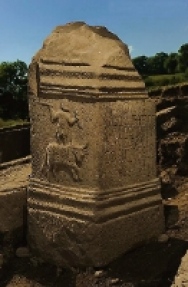
A unique religious shrine to the Roman god Jupiter Dolichenus has been uncovered at a fort along Hadrian's Wall in northern England.
The massive altar dedicated to Jupiter in the guise of a form of Baal was unearthed next to the north gate of Vindolanda Fort in Northumberland, according to a report in the Newcastle News & Star newspaper, which also published a photo of the sacred stone (left).
Director of Vindolanda excavations Andrew Birley told the paper: "What should have been part of the rampart mound near the north gate has turned out to be an amazing religious shrine with a substantial and exceptionally well preserved altar dedicated by a prefect of the Fourth Cohort of Gauls to an important eastern god, Jupiter of Doliche.
"We estimate that this highly decorated stone altar -- standing some 110cm high (4 feet), and showing the god standing on a bull holding an axe and a thunderbolt -- is around 1.5 tonnes in weight."
The ornately carved stone relic clearly shows a god-like figure standing on the back of a bull, with a thunderbolt in one hand and a battleaxe in the other, and is believed to have been used in ritual sacrifices on behalf of Roman soldiers, who were particularly devoted to the cult of Jupiter Dolichenus in the 2nd Century AD.
The inscription reads:
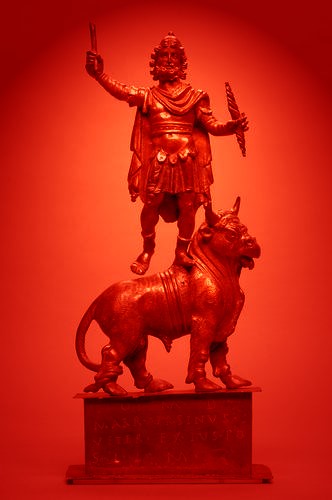
I.O.M.
Dolocheno
Sulpicius Pu
dens praef
coh IIII Gall
V. S. L. M.
"To Jupiter Best and Greatest of Doliche, Sulpicius Pudens, prefect of the Fourth Cohort of Gauls, fulfilled his vow gladly and deservedly."
Jupiter Dolichenus is a Roman deity created from the synchronisation of Jupiter/Zeus and a form of Baal worshipped in the city of Doliche near modern-day Gaziantep on the border between Turkey and Syria.
The worship of Jupiter Dolicenus flourished during the reign of Hadrian and his successors, particularly in the Roman Army, where he was regarded as all powerful and strongly associated with victory in war.
Mr. Birley told the newspaper: "Major altars like this are very rare finds and to discover such a shrine inside the fort is highly unusual.
"The shrine also has evidence of animal sacrifice and possible religious feasting.
"It all adds to the excitement of the excavations and is a once-in-a-lifetime experience for most excavators."
There was further excitement at the fort, where excavations have been going on for more than 30 years, when part of a second altar was discovered in the shrine, according to the newspaper report.
This one was dedicated by a prefect of the Second Cohort of Nervians, a Vindolanda regiment that moved to the fort at Whitley Castle further along the South Tyne Valley in the 3rd Century AD.
Vindolanda is considered one of the most exciting Roman sites in Britain, with teams of archaeologists constantly turning up new finds to go with important discoveries such as the famed Vindolanda writing tablets.
This year?s excavations continue until mid September and trench-edge talks by archaeologists are given at 2 p.m. daily during the summer holiday tourist season.
Italian news media today are reporting the discovery of a cache of exceptionally stunning statuary and other artefacts from the ancient Roman resort on the north shore of the Bay of Naples which was where Emperor Hadrian was entombed briefly and where Sacred Games were held in his honor every five years for generations after his death.
The finds were made on a scenic hilltop at the ancient city of Puteoli (modern-day Pozzuoli). Archaeologists say they have unearthed a dozen statues, columns and sculptural fragments bearing inscriptions dating them to the heyday of Puteoli as Rome's primary import-export port city during the time of the emperors.
Puteoli was also the centerpiece of a lovely bay which was an exclusive resort and playground for the rich and famous.
Experts found a marble head of Emperor Titus (below) wearing a laurel wreath. Two other male heads were found.
Two female heads were unearthed. One appears to be that of an Amazon warrior (below left) from the time of Hadrian in the 2nd Century AD. It is similar to several such Amazon heads which adorned the Canopus area of Hadrian's Villa at Tibur outside Rome.
The second marble female bust is believed to be a Roman empress from the late Julio-Claudian dynasty.
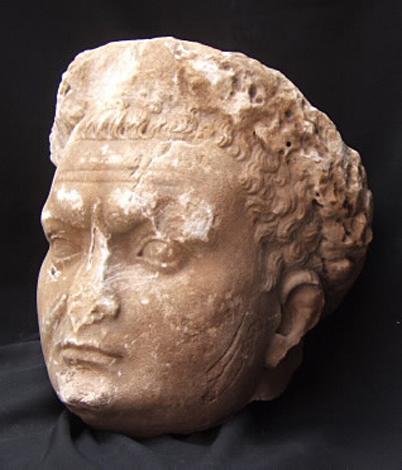
The dig also unearthed part of an equestrian sculpture and a giant mask depicting a Gorgon, also dating from the 2nd Century AD, possibly during the lifetime of Hadrian and Antinous.
Other finds include a statue of a robed woman, another of a woman wearing a toga, and a mural portraying two human figures and an enormous python or other monstrous snake.
The dig site is atop a hill, and archaeologists are convinced it was the location of one or more splendid villas or temples overlooking the sea. Only part of the site has so far been excavated.
In Ancient Rome, the northern shore of the Bay of Naples was equivalent to the Riviera or Malibu as the home of super-stars and the super-rich of the age. Each sprawling villa was more lavish than the last as well-heeled and influential residents attempted to outdo their neighbors.
The shoreline was veritably lined with solid marble, with villas and yacht landings stretching non-stop along the whole northern rim of the Bay of Naples, as shown in a mural from one such villa (above left). As synchronicity would have it, an exhibition of art and artefacts from such sumptuous bayside villas is currently on view at Los Angeles County Museum of Art until October 4, 2009. (See entry below, dated May 9th, for more details).
Long before Ostia became a major port, Puteoli was Rome's primary deep-water port for strategic cargoes such as grain from Egypt. On account of the safety and convenience of its harbor, it was preferred to Ostia for the landing of the more costly and delicate wares, such as obelisks from Egypt. As the empire expanded, Puteoli grew to be a major city where merchants and businessman sealed deals before heading off for the flesh pots of Pompeii, Baiae and other resorts which dotted the Bay of Naples.
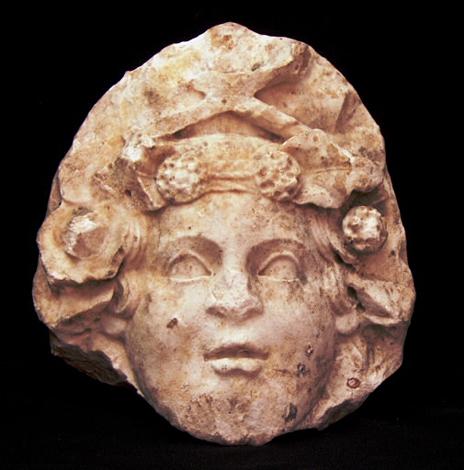
It also attracted visitors because the Romans believed its sulfuric springs marked the entrance into the earth by which Aeneas descended to the Underworld.
The famed Apollonian Oracle at Cumae is less than 10 kms (6 miles) from Puteoli. According to Roman legend, the sulfur-shrouded Cumaean Oracle cave was the origin of the the Sibylline Verses, which were consulted by the priests of Jupiter during times of dire emergency throughout the centuries of Roman history.
Archaeologists have been digging at Pozzuoli since 1993, building on major 17th and 18th Century discoveries such as the Temple of Serapis, the Flavian Amphitheatre and Cicero's Villa.
Last October the Flavian Amphitheatre was opened to the public for the first time in almost 500 years. It is the third-largest in Italy after the Roman Colosseum (which is also called the Flavian Amphitheatre) and the amphitheatre at Capua.
Hadrian's successor, Antoninus Pius, who ruled from 138 to 161 AD, built a temple to Hadrian over Cicero's villa and ordered Sacred Games to be held in his honor at the amphitheatre. Hadrian died at the exclusive ancient seaside resort of Baiae in 138 AD and was briefly entombed at his temple at Puteoli while Hadrian's Mausoleum -- in later centuries called Castel Sant'Angelo -- was being completed in Rome.
The Sacred Games, known as the Eusebeia, were held at the Greek-style amphitheatre every five years in honor of Hadrian, who was renowned for his love of Greek culture. The Sacred Games continued well into the 3rd Century AD.
Every emperor who traveled by sea passed through Puteoli, as Hadrian and Antinous also must have. One even crossed the Bay of Naples on horseback. Hadrian's notorious predecessor Caligula (who ruled 37-41 AD) staged that particularly spectacular stunt at Puteoli soon after his coronation, galloping across a two-mile pontoon bridge in defiance of an astrologer's prediction that he had "no more chance of becoming emperor than of riding a horse across the Bay of Naples".
Besides the Sibylline Verses and Caligula's crossing of the bay on horseback, Pozzuoli has two other claims to fame. It is the place where the Christian Apostle Paul first set foot on Italian soil on his way to Rome. And it also is the girlhood hometown of the actress Sophia Loren.

A new exhibition celebrates the Ancient Roman incarnation of the modern town of Tivoli, through a host of archaeological finds on public display for the first time.
Staged in the archaeological complex of the Villa Adriana - the 2nd-century palace built by the Emperor Hadrian - the exhibition spotlights the town's rise to prominence in the Roman Empire, with a particular focus on the palace, according to a report by ANSA, the Italian news agency.
Hundreds of finds have been unearthed in Tivoli, once Tibur, over decades of excavations but a large number of these have been kept in storage or shipped to museums around the country.
The ANSA report says the new exhibition offers visitors to the complex the first opportunity to admire many of these artefacts in context.
On show in the artificial Grotto of Canopus, the event boasts an array of items reflecting different aspects of Ancient Roman life. The Canopus Grotto was designed by the grieving Hadrian in memory of the final days of joy that he and his Beloved Antinous spent at the Egyptian resort of Canopus only a few weeks before the Beauteous Boy drowned in the Nile.

"No one piece stands out among the finds on show," Lazio Archaeological Superintendent Marina Sapelli Ragni told ANSA.
"Instead we have tried to select a range of pieces that convey an overall sense of the wealth and magnificence of Hadrian's Villa."
Architectural decorations from the palace point to its original elegance and luxury. Three exquisitely detailed sculptures of Hercules on display, relatively recent finds from one of the shrines on the site, are thought to be Roman copies of Greek originals, according to ANSA.
A section of a large-scale relief provides visitors with an image of Hadrian but there are also epigraphs and marble sculptures of other Roman emperors.
Located about 30 kilometres outside Rome, the town played a key role in diplomatic and trade relations between the peoples of Latium and the Italic tribe of the Sabines. Once the two sides reached peace in 338 BC, Tibur became part of the Roman world.
It fared well for the next 300 years but only came truly into its own towards the end of the Roman Republic.
As the Empire flourished, Tibur's political weight and economic importance grew, and scores of Roman nobles began settling in the area.
Sapelli Ragni told ANSA aristocrats built at least 300 residences in the town, ranging from rustic villas to sumptuous palaces. The Emperor Hadrian's decision to build his own palace in Tibur was the culmination of this trend.

Work began there in 118 AD and continued for many years, eventually producing a sprawling complex of 30 structures stretching for over a kilometre. Hadrian reportedly had a low opinion of the traditional imperial palace on the Palatine Hill in Rome and, although the Tibur villa was originally designed as an occasional retreat, the emperor eventually lived there permanently.
The Imperial court transferred to Tibur, from where Hadrian governed the empire, connected by a courier service to Rome. Although some of Hadrian's successors used the villa, it eventually fell into disuse.
Cardinal Ippolito II d'Este sealed the fate of the complex in the 16th Century when he scavenged much of the marble and statues to decorate his own luxurious villa, today famous for its fountains.
It is fitting that the current exhibition is being held at the Canopus Grotto, which many experts believe is where the Lost Tomb of Antinous is probably located.
Our own Arch Priest Antonyus Subia firmly believes the Blessed Boy is buried here. Antonyus notes that Hadrian was a gifted architect and that the design of the Villa Adriana is full of Sacred Symbolism. Antonyus Subia explains his thinking this way:
"When a visitor arrived at Hadrian's Villa, the very first thing they would encounter, placed immediately on the Right side of the entrance, was the small, enclosed Temple complex, with the Obelisk of Antinous rising from the center between two small temples, behind which was a semicircular colonnade.
"In the middle of the semicircle was a recessed chamber...a sanctuary, perhaps, that held something very sacred...Hadrian wanted everyone to pass before the sacred treasure.
"Is this The Lost Tomb of Antinous? If so, what a small tomb for The Beloved...and why would you place The Tomb of The Beloved in your Driveway? Or can it be that the Entrance was a Very sacred Place? The modern path behind the Temple complex leads to the reflecting pool and the area known as the Canopus Grotto, where many Antinous statues were found when it was first excavated 200 years ago."
It is here, at this Sacred Site that the current exhibition is located. Behold...the Temple of Antinous!
An exhibition celebrating the art, culture and luxurious lifestyle of Ancient Rome's wealthy elite has opened in Los Angeles. Entitled Pompeii And The Roman Villa, the event features over 120 items from ancient villas in the Bay of Naples destroyed by the eruption of Vesuvius in AD 79.
Pompeii And The Roman Villa will be on view at Los Angeles County Museum of Art until October 4, 2009.
The mosaics, sculptures, paintings and jewellery, some of which only uncovered in the last few years, are mostly on loan from the Naples Archaeological Museum.
The Bay of Naples area was a popular summer getaway for prominent Romans from the 1st Century BC onwards, as well as being home to a growing number of permanent wealthy residents. Emperor Hadrian spent his final months at a Naples Bay villa, where he died.
His villa was one of dozens of sumptuous seaside villas and gardens which ringed the bay, decorated in ornate style by some of the empire's greatest artists.
The exhibition, organized by the National Gallery, Washington, D.C., includes works of art from the imperial villa at Oplontis and from aristocratic villas such as the Villa San Marco at Stabiae and the Villa dei Papiri at Herculaneum, as well as works from the opulent houses of the urban elite in Pompeii, whose very name conjures up ancient Rome and other towns along the bay of Naples.
The exhibit asks visitors to imagine the Bay of Naples as a kind of modern-day Malibu in California, providing a relaxing resort for those with money to spare.
It reconstructs the homes of Rome's upper crust, which boasted lush gardens, inner courtyards decorated with valuable artworks and private swimming pools.
It also spotlights a host of luxury goods discovered by archaeologists in the 300 years since excavations first started in the area.
Solid silver wine goblets, jewelled caskets that once contained exotic perfumes and the remains of gourmet delicacies, such as flamingo tongue and roast ostrich, are among the items uncovered.
Some of the items on display are long-familiar works, others generally unknown to the public. Recent discoveries from around the Bay of Naples that have never before been exhibited in the United States will complement more familiar finds from earlier excavations.
In addition, the exhibition documents the fascination of Rome's nouveau riche with Greek culture, through books by Epicurius and Plato, garden sculptures of nude ephebes and scantily clad statues of the goddess of love, Venus/Aphrodite.
The first Roman collectors of Greek art brought it to Italy as booty. But by the 1st century BC, when villas rose around the Bay of Naples, the collections that filled them were mostly Greek-style frescoes, statuary, portraits, reliefs and mosaics made to order by Greeks who had immigrated to Italy to participate in a thriving market.
"But the pervasive use of the art of the past for self-fashioning is a particularly elite Roman thing," exhibition curator Kenneth Lapatin told the Los Angeles Times. "All the upper classes went to study in Greece." Warts and wrinkles in so-called realistic portraits of Romans made the subjects appear tough and hard-working, he said, "but when they went to their country homes, they would suddenly become Greek philosophers and talk about Greek culture. It's kind of like the Russian courts speaking French. Schizophrenia may be too strong a word for it, but different hats for different audiences in different places."
The exhibition arrived in Los Angeles following a successful run at the National Gallery of Art in Washington.
Speaking ahead of the Washington opening, Campania region Social Policies Councillor Alfonsina De Felice, said she hoped the exhibit would help visitors look beyond media stereotypes and interest them in the real beauties of the southern region.
"This is a marvellous exhibit that will help us show the real Campania, a treasure trove of rare and precious items," she said.

Hadrian's Wall is tweeting into the 21st Century thanks to Twitter, amid media hype surrounding the grand opening of a stunning new museum with the world's largest collection of Wall artefacts.
The $75-million Great North Museum in Newcastle-upon-Tyne, UK, is set to open to the public on 23 May. And Twitter will help you become part of the museum's grand opening.
Just when you thought people had run out of things to do with Twitter, along comes the Hadrian's Wall Heritage organization with a Twitter Writing Challenge no less....
The online social networking site is being used to keep the Wall in touch with the outside world. Hadrian's Wall Heritage want local families, tourists -- and even those of you around the globe who have yet to experience the landmark -- to get on their PCs and post their thoughts on the Wall in no more than 140 characters (about 20 words).
The idea is to write a Tweet about Hadrian's Wall. You have just the 140 characters allowed by Twitter to get your message across and your message must contain the words "Hadrian's Wall".
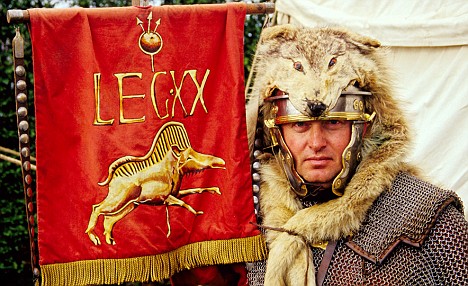
That's it, simple. Other than that, you can write what you want. The winner will land a neat Apple iPod nano 8GB and the competition will be judged by British author and broadcaster Eric Robson, who is also a board member of Hadrian?s Wall Heritage Ltd.
"We want to see just how well people can write about the Wall with only 140 characters available to them.," he said at a news conference. "I think it'll be a great test of people's creative writing skills! The key to success will be thinking very carefully about the words you use.
"It doesn't matter whether or not you?ve had the chance to see Hadrian?s Wall first hand yet. You could write about your experience of visiting the Wall or maybe just what you think about Hadrian's Wall as an engineering achievement. You could even create a very short story about Hadrian's Wall. The sky's the limit."
Hmmm... a very short story, indeed. The whole point of the competition is to promote the Living Frontier historical re-enactment event between May 26th and 31st - when among other things, people dress up as Roman soldiers to guide tourists along the wall. The competition also specifically boosts the wall's Twitter presence at www.twitter.com/EmperorHadrian which is promoting the event.
Using the Twitter profile "Emperor Hadrian", the team at Hadrian?s Wall Heritage is updating people about all the exciting events that are planned between May 26th and 31st.
More details of that are available from The Living Frontier.
Deadline for entries is 5 p.m. (British "Summer" Time) on May 15th. You can either mail your entry to: comms@hadrianswallheritage.co.uk or add it to The Wall at the Living Frontier Facebook page - yes, they have one of those too....

Meanwhile, the Great North Museum in Newcastle is set to open to the public on May 23rd after more than a decade of planning and construction.
The museum will bring together the natural history collections and archaeological exhibits that were housed in the Hancock Museum and Museum of Antiquities and Shefton Museum at Newcastle University into one flagship museum for Northern England.
Highlights of the new museum include a life-size replica T. rex skeleton, mummies from Ancient Egypt, and a superb collection of Greek art and Hadrian-era Roman archaeology.
Visitors can track the story of planet Earth from its place in the universe -- brought to life in the Museum's planetarium -- through ancient world civilisations, to natural history and life today.
A special highlight is the new Hadrian?s Wall Gallery which displays exhibits from the entire length of the wall in the single greatest collection of artefacts from the Hadrian's Wall World Heritage Site.
Visitors can discover the history of Rome?s northern frontier, including an inscription stone which proves that the wall was built on the orders of Emperor Hadrian.
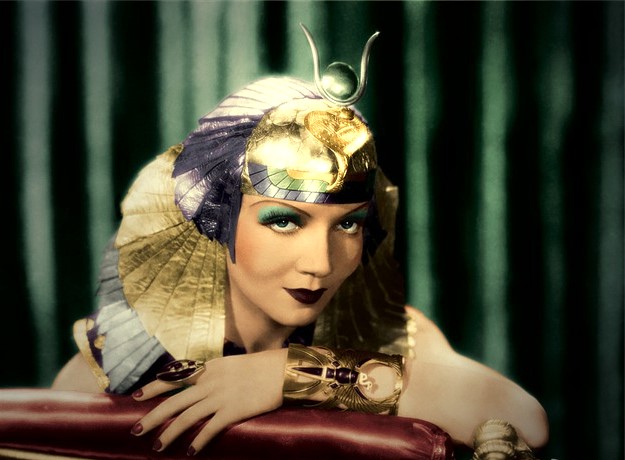
There's big news today about the possible discovery of the LOST TOMB OF CLEOPATRA in catacombs below the ruins of ancient Taposiris, a Sacred City a few kilometers inland and slightly west of Alexandria.
For three years, archaeologists have been exploring the underground labyrinth, turning up a bronze statue of the goddess Aphrodite, the alabaster head of a Cleopatra statue, a mask believed to belong to Marcus Antonius and a headless statue from the Ptolemaic era.
Now, radar scans have revealed tomb-like structures which conceivably could be those of the ill-fated lovers, according to Zahi Hawass, 61, the head of Egypt?s Supreme Council of Antiquities.
The location is of great interest to those of us who love Antinous because it is very likely that Hadrian and Antinous visited this temple site in the final summer of the brief life of Antinous.
As we know, the imperial entourage was visiting Alexandria in the summer of the year 130, and we know that Hadrian and Antinous hunted and killed a man-eating lion which had been terrorizing the countryside. It was described as a "Libyan" lion, "Libya" being the term used in those days for everything west of Alexandria.

So it is highly possible (even likely) that the imperial hunting party passed by the temple at Taposiris Magna, which is less than 45 kms (30 miles) west of Alexandria. In the year 130 it was a vast complex of temples that included a Roman fortress. The name Taposiris comes from the legend that one of the relics of Osiris was enshrined there.
This is a very noteworthy site because it is the location of the only wholly Greek style temple (with columns) ever known to have been built in Egypt. And it is also a temple which was converted into a military fortress by the Romans.
In addition, it is the location of a unique stone tower overlooking the sea which is believed to have been a miniature replica of the Great Lighthouse at nearby Alexandria.
Only shattered walls and foundations are left to indicate the size of Taposiris Magna.
It is entirely conceivable that Cleopatra and Marcus Antonius, cornered by Octavian's advancing forces, might have sought refuge at this fortified temple complex with its tower suitable for use as an observation post. It is also entirely possible that Cleopatra and Antonius were buried here.

An even more intriguing possibility is that the Lost Tomb of Alexander the Great might be located here. His rock-crystal sarcophagus was variously located in ancient Memphis and Alexandria, but no one knows where it might be today. Is it possible that Hadrian and Antinous stopped at Taposiris Magna to take a look at Alexander resting in his crystal coffin?
The reported system of tunnels and catacombs under the temple complex is not surprising. It was commonplace for treasures to be buried in chambers under Egyptian temples. Sacred statues would be "deconsecratred" and entombed under the paving stones of temple floors in order to make way for new statues -- otherwise the temples would be overflowing within a few generations. Hundreds of such "retired" statues have been found under the Temple of Amun at Karnak.
The practice continued into Christianity, which is why many old churches have crypts in which sacred items (and important people) are buried so as to be in sacred consecrated soil.
This possibility might also be a clue to the Lost Tomb of Antinous. Perhaps he is buried in a chamber below the Great Temple of Antinoopolis or else under the Divine Hadrian's Villa, or possibly in a vault under Hadrian's Mausoleum.
If Hawass is right, he could make the greatest archeological discovery in Egypt since Tutankhamun?s tomb was uncovered by the British archeologist Howard Carter in 1922.
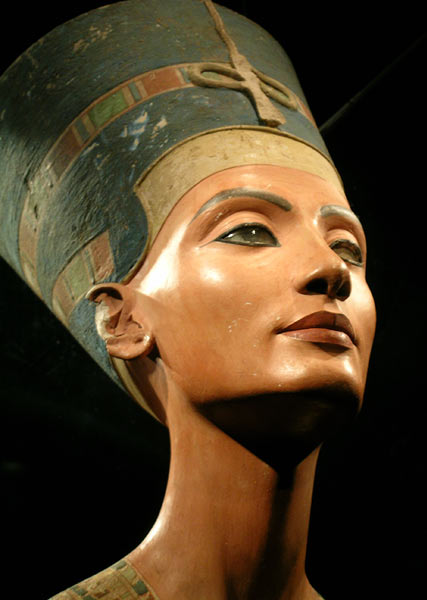
Using 21st Century medical computer technology, German researchers have unveiled the "hidden face" below the surface facial features of the famed 3,300-year-old bust of 18th Dynasty Queen Nefertiti ? dispelling once and for all nagging rumors that the bust might be a duplicate made at the orders of Adolf Hitler in the 1930s, and that the genuine bust might have been lost in the chaos following World War II.
The researchers from the Imaging Science Institute at Berlin's Charit? Hospital made a series of CT scans of the bust and confirmed findings of a less sophisticated CT scan 17 years ago which revealed that the sculpture has a limestone core and is covered in layers of plaster-like stucco, or "render", to use the more precise technical term.
That finding in itself was of course not new. But what was new is the amazing fact that the new CT scan revealed that the limestone core was carved with such artistic precision that it forms a veritable inner copy of the outer face.
The experts say the limestone facial features are a bit rougher and more angular (pointed out by the arrows below) than the plaster features (asterisks). Now the Berlin experts are wondering whether the original artist originally carved the bust in limestone, but then changed his mind and added a plaster glaze which gave the queen softer and more rounded features. Or did the queen herself insist on the softer, botox-like look?
It is a question which may never be answered. But the latest CT scan does answer the lingering question as to whether the bust which forms the cornerstone of Berlin's Egyptian collection is genuinely 3,300 years old -- or whether it is a fake made 70 years ago as part of a scheme by the Nazi f?hrer to assuage Egyptian ire by giving them a fake bust of Nefertiti, while Hitler kept the original for his own private collection.
The Berlin experts are satisfied that no 20th Century artist, commissioned by Hitler to make a museum copy, would have gone to the trouble of carving a limestone bust in exquisite detail and then hiding it below a coat of plaster. No one knew what lay beneath the plaster.
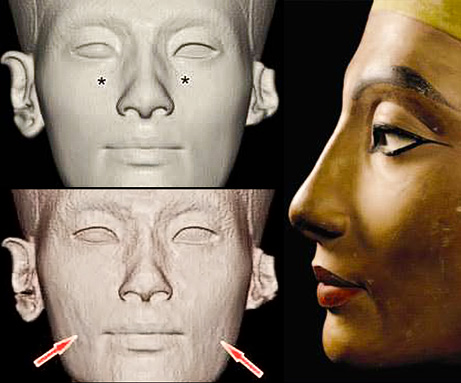
For years, the Berlin officials have argued that chemical tests showed the paint and plaster on the bust were identical to those used by Ancient Egyptian artesans. Now they have computer-backed evidence that the bust is indeed genuinely ancient.
Egypt has demanded the return of the bust since it went on display in 1923 in Berlin at the height of worldwide "Egyptomania" in the wake of the discovery of the tomb of Tutankhamun by Howard Carter.
The painted limestone and plaster bust, depicting the elegantly chiseled life-sized features of a stunningly beautiful woman wearing a unique cone-shaped headdress, has been the pride of the collection since German archaeologists discovered the bust in the ruins of an ancient artist's studio on the banks of the Nile in 1912.
An alluring mystery has surrounded the bust since its discovery on December 7, 1912, incredibly intact and sporting vibrant colours, after lying in forgotten in the sands since the tumultuous days at the close of the reign of Pharaoh Akhenaten, one of the most enigmatic rulers of all time -- a ruler whose sacro-artistic beliefs were so revolutionary that his successors erased his name from monuments so that his name would die.
The find was made at the "heretic" king's "City of the Horizon", which is only 20 kms (12 miles) up the Nile from the Sacred City of Antinoopolis. Both cities are located at the spiritual fulcrum of Egypt, midway between Memphis and Thebes.
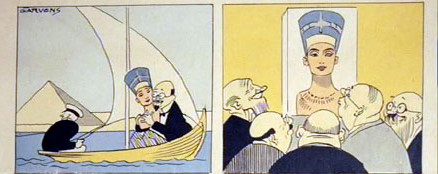
In 1913, the Ottoman Empire agreed to allow the finders of the bust, part-time German-Jewish archaeologist and full-time entrepreneur James Simon and his Prussian colleague Ludwig Borchardt, to retain possession of the bust. Cairo later said it had been tricked.
The simmering controversy between Egypt and Germany boiled over anew earlier this year when a German news magazine printed excerpts from documents which allegedly indicated Borchardt deliberately used subterfuge to "smuggle" the bust out of Egypt. The letters only prove that he did not need to be devious, he counted on the fact that the authorities were incapable of appreciating what soon would be called "Amarna Art".
The embarrassing truth for Cairo is that the Ottoman Empire officials very simply -- but very understandably -- did not see the artistic value of the artefact.
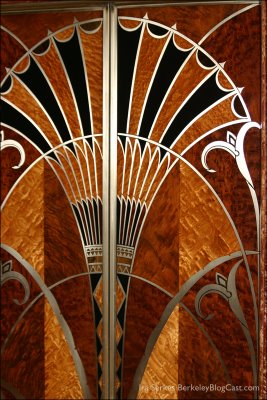
Despite persistent rumors that Borchardt and Simon smuggled out the bust under a coating of mud, the plain truth of the matter is that Ottoman authorities failed to recognize the bust as a masterpiece. In those days, the uniquely fluid style of the Amarna Period was viewed as an "aberrant" deviation from traditional styles of other Egyptian periods.
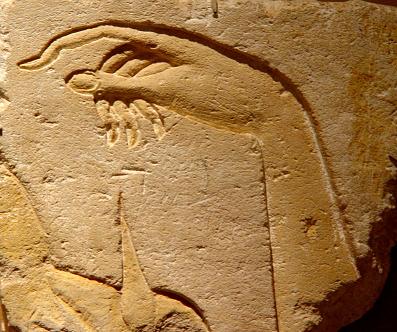
Borchardt and Simon, however, immediately recognized the bust's appeal to European tastes for Art Nouveau and other post-Victorian styles.
So they did indeed breathe a sigh of relief when the Ottoman authorities blindly gave their stamp of approval to their request for removal from Egypt.
Borchardt and Simon carted it off to Europe where Simon displayed Nefertiti prominently in his home in Berlin before later lending it to the Berlin museum and finally donating it in 1920 to the Berlin museum. The timing could not have been more fortuitous.
The discovery of Tutankhamun's tomb in 1922 spawned an Egyptomania craze as well as the Art Deco style. King Tut's treasures flaunted the "aberrant" style of the late 18th Dynasty, and Nefertiti suddenly was a fashion trend-setter.
Crowds flocked to the Berlin museum to see Nefertiti and shame-faced Egyptian authorities realized they had made a ghastly mistake a decade earlier.
"They suddenly realized that this bust, which had been dismissed as 'un-Egyptian' in 1913, was in fact one of the most exquisite examples of Egyptian art," the Berliner Zeitung newspaper quoted one expert as saying.
When Hitler came to power in 1933 the Egyptian government renewed its demands for Nefertiti's return -- counting on Hitler's anti-Semitism. Hermann Goering was new premier of Prussia, including Berlin. As head of Berlin's museums, Goering hinted to King Fouad I of Egypt that Nefertiti would indeed soon be back in Cairo.
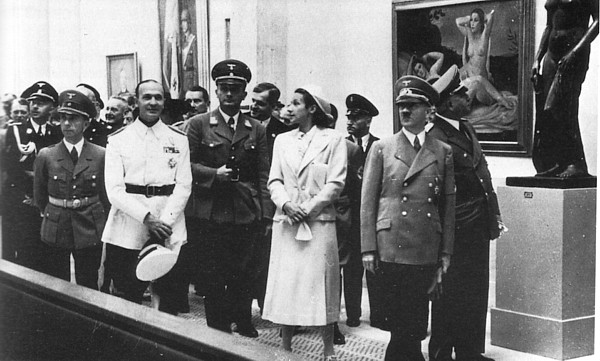
But Hitler had other plans. Through the ambassador to Egypt, Eberhard von Stohrer, Hitler informed the Egyptian government that he was an ardent fan of Nefertiti:
"I know this famous bust," the fuehrer wrote. "I have viewed it and marvelled at it many times. Nefertiti continually delights me. The bust is a unique masterpiece, a precious adornment, a true treasure!"
Hitler said Nefertiti had a place in his dreams of rebuilding Berlin and renaming it Germania.
"Do you know what Im going to do one day? I'm going to build a new Egyptian museum in Berlin," Hitler wrote.
"I dream of it. Inside I will build a chamber, crowned by a large dome. In the middle, this wonder, Nefertiti, will be enthroned. I will never relinquish this bust of the Queen."
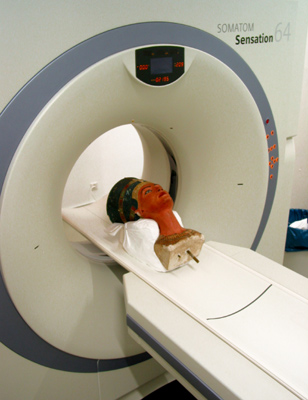
While he did not mention it at the time, Hitler envisioned more for the museum. There was to be an even larger hall of honor, with an equally grandiose bust of Hitler.
It was rumored immediately after World War II that Hitler had commissioned a copy of the bust for possible handover to the Egyptians after a Nazi victory. American Allied art experts claimed they found two wooden crates in a salt mine south of Berlin where the German capital's museum art treasures had been placed by the Germans for safekeeping during bombing raids. The two crates allegedly contained identical Nefertiti busts.
But in post-war confusion, one of the crates got lost. One of the crates was sent to some sort of an Area 51 depot in the US. The whereabouts of the "other Nefertiti" are unknown -- assuming it ever existed to start with. From time to time over the years, there have been reports suggesting that the fake bust survived and that the genuine bust may be lost. A documentary on Germany's ZDF television network revived that theory in 2007.
And that is where the new CT scans come to the rescue. They prove once and for all that the bust on view in Berlin is indeed genuine. Whether there ever was a duplicate is now irrelevant. The real Nefertiti is in Berlin.
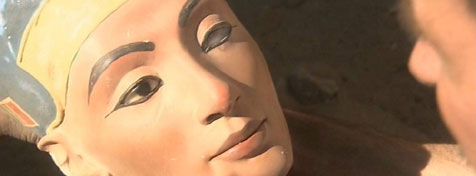
The exquisite limestone bust of Queen Nefertiti forms the focal point of the Berlin collection, which ranks among the top two or three collections in the world outside Egypt itself.
The British Museum, the Louvre in Paris and the Metropolitan in New York are the only chief rivals to Berlin's collection, which spans all eras of Egyptian art.
Hitler's dreams of a monolithic new Egyptian museum never materialized. Instead, Nefertiti will move into permanent quarters in Berlin's Neues Museum later this year, following years of painstaking renovation work to erase wartime damage.
Ironically, it will be the first time since 1939 -- exactly 70 years ago -- that the entire Berlin Egyptian collection will be on public view in one permanent location.
Hitler and his mad dreams are long dead. But Nefertiti continues to smile serenely. As she has for 3,300 years. As if to say, this too shall pass. And I shall endure.
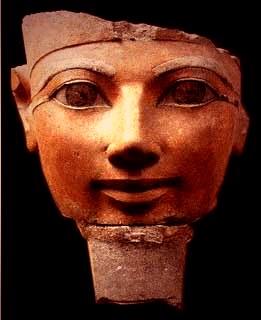
The latest thing in scents next year could be the oldest perfume in the world, made especially for an Ancient Egyptian female pharaoh, according to German scientists who are analysing residue found in a 3,400-year-old perfume flacon.
The German researchers at the Bonn University Egyptian Museum say they will use the analysis to recreate the original perfume which was buried in an exquisite alabaster vessel bearing the royal insignia of Maatkare Hatshepsut ? the most powerful woman ever to rule dynastic Egypt, and arguably the most powerful female ruler in ancient history.
The intact perfume jar has remained sealed since it was interred in the Valley of the Kings 1,400 years before Cleopatra, last of the Ptolemies and a veritable vassal of Rome. On a hunch, the Bonn Egyptologists recently ran a CAT scan which revealed 3-D images of a residue at the bottom.
"No one had ever done that before," says museum curator Michael Hoeveler-Mueller. "We were frankly over-joyed at the findings. And now we are conducting a chemical analysis of the residue in hopes of being able to recreate the exact original perfume."
The experts hope to recreate the scent by the end of this year, he told the Bonn newspaper General-Anzeiger.

"We think it probable that one constituent was frankincense -- the scent of the gods," he added.
That theory is based on the fact that Hatshepsut sent an expedition to the Land of Punt, modern-day Eritrea, which returned with gold, ivory, ebony and living specimens of frankincense trees.
The frankincense trees were planted in a vast irrigated garden which spread out in front of her cliff-side mortuary temple directly across the Nile from the Karnak Temple of Amon, the god she said had been her heavenly father.
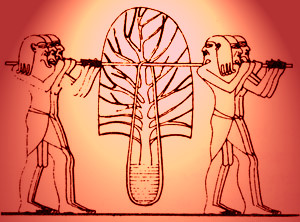
She was the granddaughter of powerful warrior pharaohs who had wrested Egypt from foreign rule by the hated Hyksos, founding the 18th Dynasty and ending a century of chaos which was forever etched on the memories of Egyptians as something to be avoided at all costs in future.
Against that backdrop, Egypt was left in the lurch when her kingly husband, Thutmose II, died at an early age. He left only Hatshepsut and a small son by a secondary wife. Thus Hatshepsut became co-regent with her small step-son Thutmose III. She later proclaimed herself "king" and portrayed herself as a male and ruled for 22 years until her step-son Thutmose III grew to manhood and succeeded her.
Under her two-decade rule, Egypt enjoyed a peaceful and prosperous time. Yet after her death, the "female pharaoh" was scorned, her images and inscriptions mutilated and her monuments demolished.
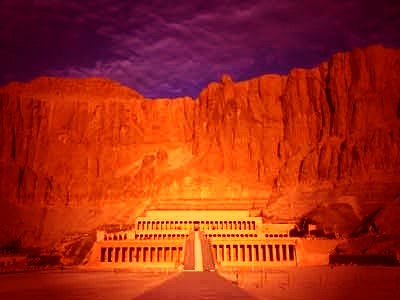
When she was "rediscovered" in the 19th Century, Hatshepsut was regarded as a kind of ancient Queen Victoria, a widow who presided wisely over a vast empire. But in the mid-20th Century, her image changed dramatically, primarily due to lurid and highly fanciful novels and headline-making TV specials seeking to boost ratings with whispers of ancient sex and intrigue.
It has been claimed she was a wicked stepmother who usurped innocent little Thutmose and who had a liaison with the architect who built who mortuary temple and who, according to some versions, was in fact the power behind the throne.
But those claims are almost entirely conjecture owing to the simple fact that there is virtually no historical record. Sensationalistic fluff helps to pad out an hour-long TV show.
In recent years, British Egyptologist Joyce Tyldesley has gone far in giving Hatshepsut's battered image a "re-launch". In books, articles and on TV, Dr. Tyldesley dispels many of the "wicked stepmother" tales surrounding Hatshepsut and presents a lucid portrait of a very level-headed ruler who loved her country more than she loved any man ? a bit like Elizabeth I of England.
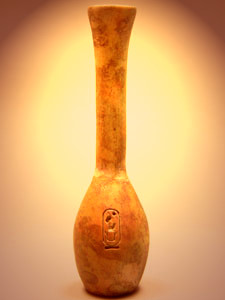
Tyldesley points out that Hatshepsut's father and grandfather had fought strenuously to unite Egypt after 100 years of chaos and foreign rule under the heel of the despised Hyksos.
The royal bloodline descended via the mother, so it was imperative that Hatshepsut bear a male child ? which she did not. When her husband died at a young age, the only male heir was a small boy born of a secondary wife who was not of royal blood.
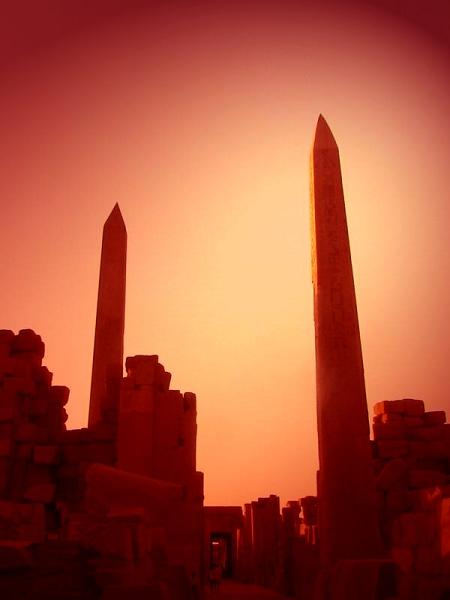
Tyldesley says Hatshepsut feared Egypt would descend into chaos and civil war unless she took action ? drastic action worthy of the daughter of warrior kings. So she proclaimed herself "king" and rightful heir to the throne of her warrior forefathers (and her heavenly father Amon) who had brought peace and prosperity to Egypt after generations of turmoil.
In doing so, she bought time for her little step-son to grow to manhood. She taught him to become a warrior king himself, worthy of being entrusted with power. And it worked. Thutmosis III became the greatest warrior king in all of Egyptian history. He expanded the empire to its greatest extent. The 18th Dynasty, started by her grandfather, became a period of unparalleled political stability known as the New Kingdom.
The historical facts show that she allowed her stepson to grow to manhood, gave him full control of the armies at a very early age and schooled him in statecraft before relinquishing power when he was an adult. As for why she called herself "king", Tyldseley notes that there was no word in the Egyptian language for "female sovereign" so she had little other choice.
It is also historical fact that her name was chiseled off of all monuments a number of years after her death. It is not known who is responsible for trying to erase her name from the records. Perhaps it was her stepson. But if so, then why did he leave other highly visible monuments showing him together with her in harmony as co-regents?
We can only assume that someone at some later date considered it to be a dangerous precedent for a woman to call herself "king".
Of her monumental construction work, only two great obelisks at Karnak and the mortuary temple at Deir al-Bahari remain.
And a flacon of perfume with her name on it -- as "king" of Egypt.

Taking inspiration from a homesick Ancient Roman Centurion's dinner party dessert menu, a luxury ice cream maker in Britain has created the first-ever range of Roman ice cream flavors. The ice cream comes in specially designed cardboard Roman pots and is on sale at museums and specialty shops along Hadrian's Wall in northern England.
The three varieties -- Apple-Cinnamon, Cherry and Honey -- are all flavours which were enjoyed by Roman soldiers when the Emperor Hadrian visited provincial Britannia 1,800 years ago.
The flavors were inspired by one of the Vindolanda Tablets in which a Roman soldier stationed at Hadrian's Wall urged his staff to secure "a hundred apples, if you can find half-way decent ones".
The new range of flavors, created by Northumberland-based Doddington Dairy, were being officially launched at this week's Hadrian's Wall Country Locally Produced Trade Fair in Hexham.
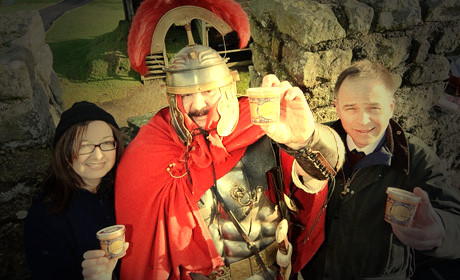
Those who attended could tempt their tastebuds with an exclusive sample of the hand-made ice cream before they hit the shelves.
The Roman ice creams will be stocked at Vindolanda, Segedunum, Housesteads Roman Fort and other outlets in Hadrian?s Wall Country and the North East of England.
Neill Maxwell, of Doddington Dairy, said: ?The Roman tablet sparked our imagination to bring together new flavors from ancient roots.
"Britain has always been well known for its apples and honey and one of the reasons we picked the cherry flavor was because the Romans introduced a better flavor of eating cherry into the country," said Maxwell, shown at right with fair official Julie Sloan and Centurion Marcus Aufidius Maximus, who guards Hadrian's Wall these days.
The cherry tree originated in Asia Minor, modern-day Turkey, which is the birthplace of Antinous the Gay God. He would have eaten cherries as a small boy.

"Response so far has been very enthusiastic and we are hoping to have Roman ice cream available along the length of Hadrian's Wall this summer," Maxwell told the Newcastle Journal newspaper.
Hadrian and Antinous would have been familiar not only with apples, cinnamon, honey and cherries, but also with flavored ices. The Roman version of ice cream was made from snow and was sweet with honey and the juice of grapes and various fruits. Flavored ices were rumored to be a favorite of Emperor Nero.
Lindsay Allason-Jones, director of the centre for interdisciplinary artefact studies at Newcastle University, told The Journal: "We know that the Romans enjoyed their food and if they had been able to freeze their ice creams, these would certainly be some of the flavors they would have sampled."
Julie Sloan, spokesperson for the fair where the ice cream was unveiled, added: "The Roman themed ice creams are a great idea and we're delighted that they are being launched at the trade fair.
"Doddington Dairy is an excellent example of the high quality producers we have in Hadrian?s Wall Country and I'm sure these new flavors will be a great success with local people and visitors alike."

The Vindolanda Tablets are small sheets of wood which Roman soldiers used as "postcards" or letters home. These shards of brittle wood are as important to historians as any pristine statue or other monument.
Now known as the Vindolanda Writing Tablets - after the Roman Fort where they were found - the more than 1,000 pieces of birch, alder and oak give an unparalleled, moving and often very funny insight into the life of the Roman soldier stuck miles from home at the turn of the 2nd Century AD.
The letters, found nearly 40 years ago, tend to be from officers and were found in the ruins of the praetorium, the residence of the officers commanding the Vindolanda units from AD90 to 120, just before Hadrian's Wall was built between 122 and 130 AD, which coincide with years when Hadrian and Antinous traveled together. Some Antinoian experts believe it is even possible that Antinous visited Britain.
The wall eventually stretched 74 miles (120 km) from Solway Firth in the west to Wallsend on the River Tyne in the east.

The letters reveal how the soldiers miss their family and friends back in Gaul - that's where most of them came from.
How they long for fine Italian wine. How they dread the attacks of the vicious Picts - the woad-encrusted savages from the north whose raids were to be held off by the new wall of turf and stone stretching across the neck of England.
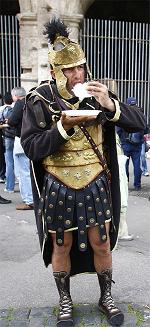
But most of all, how cold they are in the frozen north, a few miles north of modern Newcastle-upon-Tyne.
The funniest letter is a simple list of the clothes sent from the warm south to a poor frozen Roman: "Paria udonum ab Sattua solearum duo et subligariorum duo." Or - socks, two pairs of sandals and two pairs of underpants.
Two pairs of underpants! We tend to forget that the Roman Empire, the greatest the world has ever seen, stretching from Scotland to Nubia, from Gibraltar to Turkey, had to be patrolled by thousands of soldiers. And soldiers, like all of us, are humans. And humans need socks and underpants.
And snacks which remind them of home. Apple-cinnamon, or honey or cherry flavored ice cream, for example.
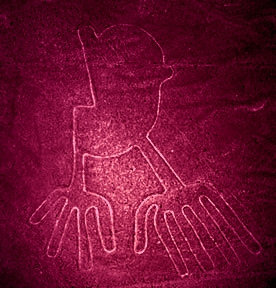
Torrential rains of a freakish nature have ruined a portion of the famous Nazca Lines in Peru.
The tips of three fingers of a geoglyph known as "The Hands" were obscured under a deluge of liquified desert clay sludge spawned by exceedingly rare rainfall.
Mario Olaechea of Peru's National Culture Institute told The Associated Press that water from the unusually heavy rains washed off the nearby Pan-American highway and created a clay-mudslide.
The AP report quoted Olaechea as saying experts will attempt to repair the damage.
The lines are shallow designs in the ground which form the outlines of hundreds of figures, ranging in complexity from simple lines to stylized hummingbirds, spiders, monkeys, fish, sharks or orcas, llamas, and lizards.
No one knows who made these geoglyphs, or why. The dry, windless, stable climate of the plateau has preserved the mysterious lines for 1,000 years.
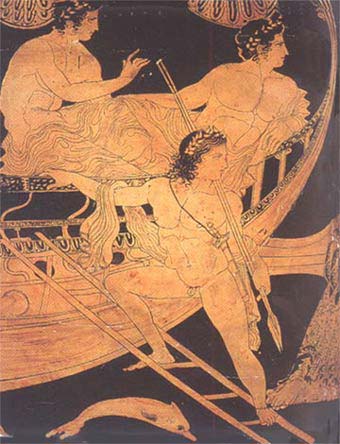
The largest and most complete ancient Greek ship ever found is being rebuilt by marine archaeologists in Portsmouth, England. This ambitious project entails reassembling the remains of a 2,500-year-old Greek trading vessel recovered last July from the bottom of the sea off Sicily.
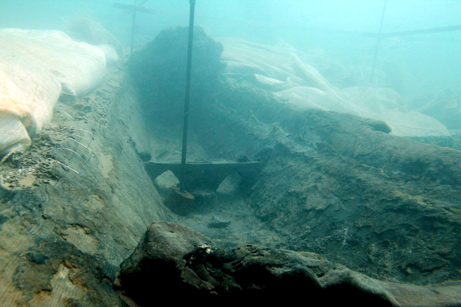
It has a length of nearly 70 feet (21 meters) and a width of 21 feet (6.5 meters).
That makes it the largest recovered ship built in a manner first depicted in Homer's Iliad, although Homer's epic is believed to date back several centuries earlier than this vessel.
Nonetheless, Rome was just a collection of mud huts on seven hills along the Tiber when this proud ship was plying the Mediterranean.
After being discovered in silt off the coast of Sicily, the 700 sodden timbers were submerged in water-soluble wax for four months. They were then freeze-dried in a huge vacuum chamber and are now ready to be reassembled in a painstaking procedure expected to take a decade.
The reassembly project, which begins this week, is under the auspices of the Mary Rose Centre, named for the 16th Century British warship, a surviving part of which was restored by the Portsmouth experts. The Mary Rose Centre is acknowledged as the best place in the world for restoring fragile ancient marine artefacts, and the Greek trading vessel is an exciting challenge to the centre's experts.
Charles Barker, of the Mary Rose Centre, said: "It has an elm keel, an oak frame and pine planking. It is the most complete Greek trading vessel yet found."
Archaeologists believe the craft was heading for Gela, then a Greek colony, when it must have been caught in a storm and sank with its cargo.
Once reassembled, the remarkable vessel will be returned to the Sicilian town of Gela, where officials hope to display it in a planned new sea museum.
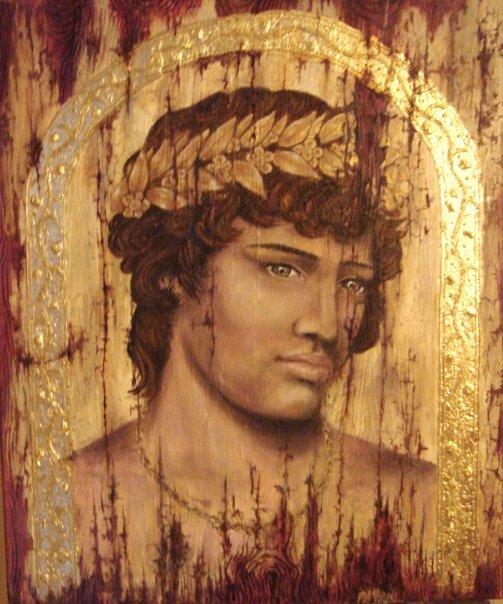
Fresh on the heels of the British Museum's blockbuster Hadrian: Empire and Conflict show last year, another London museum will explore how influential his lover Antinous has been as a gay icon from the Roman period up to the present day.
The Petrie Museum of Egyptian Archaeology will stage an art exhibit and special two-part seminar on Antinous during Gay History Month in February.
Centerpiece of the art exhibit are stunning encaustic wood portraits of Antinous (seen at left) and Hadrian by the London-based artist Andrew Prior.
The show will also feature modern portraits by Andrew done in the style of the famous Fayoum Portraits, which were found by the hundreds in the necropolis of the Sacred City of Antinoopolis.
The portrait at the top of this page is one such encaustic (wax) painting, known as the portrait of "The Two Lovers", and which features images of Antinous and Hermanubis hovering over the two men's shoulders.
Andrew practices his art in a wide range of media including works on paper canvas and wood, fashion design, interior design and jewellery design and manufacture.
He often works to commission, but also uses the inspiration of the ancient Mediterranean for his own personal creations, including the portraits in this exhibition which are inspired by the mummy portraits of Antinoopolis.
The portraits in this exhibition, with the exceptions of Hadrian and Antinous, are all from life and are acquaintances of Andrew.
The image at left is Andrew's glorious portrait of Antinous.
Using the painstaking techniques of 2nd Century AD artists in Antinoopolis, Andrew has applied tempera mixed with hot wax to wood, and has applied a gilded ornamental border. He has "aged" the portrait, giving it the appearance of an authentic Antinoopolis necropolis portrait. The show runs all month.
On February 26th, the museum will hold a special seminar entitled Antinous: Gay Icon? which will explore how influential Antinous has been as a gay icon throughout history. The evening begins at 6:30 p.m. with a talk by John J. Johnston on Antinous and sexuality in Roman Egypt, followed at 7 p.m. with a discussion by Cathie Bryan on the continuing reception of Antinous as a gay icon up to the present time. Admission is free.
The Petrie Museum of Egyptian Archaeology is open Tuesday to Friday from 10 a.m. to 5 p.m. and on Saturdays from 10 a.m. to 1 p.m.
For further information, call +44 (0)20 7679 4138. But be forewarned -- no one may answer the phone because the museum is currently closed owing to lack of heat.
Where are Hadrian's imperial plumbing and heating engineers when you need them?
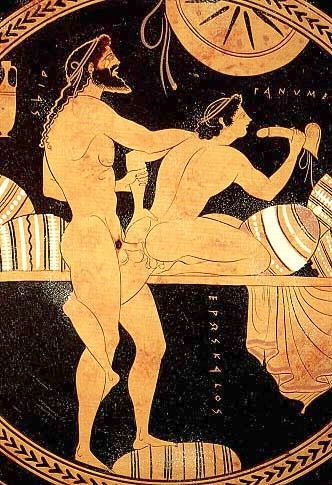
The ancient Greeks may have routinely operated commercial taverns and brothels right inside their own homes, according to a controversial new theory by a leading expert.
If true, the theory by Clare Kelly Blazeby, an archaeologist at Leeds University in England, would explain why archaeologists find pubs and whorehouses on practically every street corner in ancient Roman towns -- but no such commercial establishments in the ruins of Ancient Greek cities.
Experts have always assumed that the many depictions of lavish banquets and orgies in Greek Art merely reflected the sort of hospitality which the Ancient Greeks enjoyed in the privacy of their own homes.
But the new theory suggests that the Ancient Greeks had a very different concept of what "hospitality" was, and that they very likely believed that "my home is your home" meant opening their doors to paying customers.
Instead of going out to bordellos and bars, perhaps the Ancient Greeks simply did it all at home. The idea of not having a tavern or paid-admission orgy room in your home would have been as strange to them as the idea of not having a kitchen or bathroom would be to us.
Kelly Blazeby bases her theory, which has raised eyebrows among archaeologists, on an analysis of artefacts found in private Greek houses dating from 475 to 323 BC.
She discovered that several had enormous stocks of drinking cups -- hundreds of cups -- far too many for entertaining ordinary guests, New Scientist magazine reported. The clear implication is that private homes were not just "private homes", they were also "public houses" in the modern sense of "pubs".
"This blows apart everything that people think about drinking in classical Greece," says Kelly Blazeby, who will present her findings this month at the annual meeting of the Archaeological Institute of America in Philadelphia. "A lot of trade and industry was based within the home."
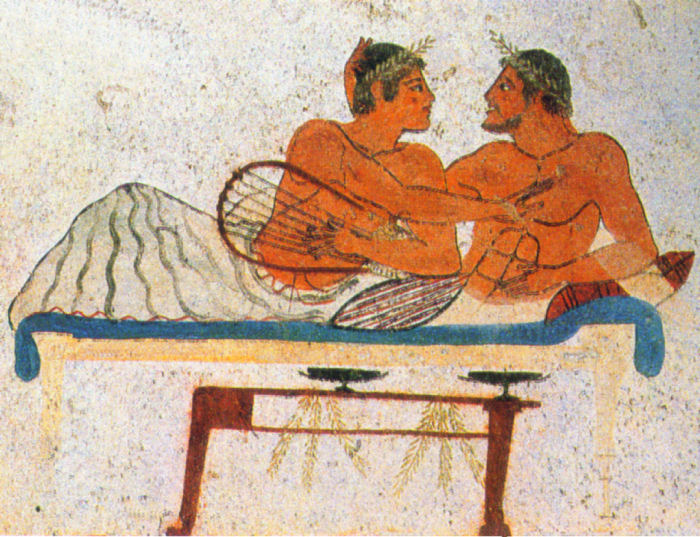
The artefacts came from houses located in various parts of Ancient Greece, indicating a widespread custom, and not just a local phenomenon.
Up until now, experts have assumed that these homes were wealthy residences where lots of entertaining went on.
But Blazeby believes a more likely explanation is that the house owners regularly opened their doors to paying patrons, perhaps operating the equivalent of what today would be private clubs.
Her analysis has been bolstered by another expert, Dr. Allison Glazebrook from Brock University in St Catherine's, Ontario, Canada. He says he independently arrived at the same conclusion.
She will go even further by telling the conference that some of the homeowners not only had rooms for selling wine, but also for gambling and prostitution, based on erotic graffiti and telltale decor.
"This has a real impact on how we view the economy in classical Greece," she says.
She insists that the logical conclusion has been staring archaeologists in the face the whole time, but experts have not been able to divorce themselves from their modern mind-set in order to come to the logical conclusion -- that the Ancient Greeks had a radically different concept of "home" vs. "public" entertainment.
"If you look at the remains coming from ancient Greek homes, it seems very clear to me that these buildings had another function, that some areas were used for commercial purposes," she said. "It's amazing how entrenched people in the field are. We are trying to change archaeologists' minds by pointing out that houses could be used economically as well being residences."
Among the sites analysed were the Villa of Good Fortune in Olynthus and a residence known as Building Z in Athens. Building Z is located in an area of Ancient Athens which experts have determined was a center of prostitution. Archaeologists working at the site found huge quantities of ancient cups, but also noticed that the room had unusual cubicles around the perimeter.
"It may have been a place where men went to drink and where they could choose a prostitute," says Kelly Blazeby.

The Villa of Good Fortune is unusual in having two "androns" (rooms for men only) with floors patterned with mosaics relating to good luck and drinking.
She thinks that could well mean that the room was used as a gambling casino.
The new theory goes a long way towards explaining the well-known mixture of grudging admiration and outraged disdain that the Ancient Romans had for their Greek neighbors to the east.
They admired the Greeks for their art and philosophy, but were continually shocked by Greek moral laxity, which the Romans considered undignified.
The Romans didn't mind having taverns and whorehouses on every street corner as long as the appearance of a dignified family home life was maintained.
Romans were stunned when Caligula opened a house of prostitution in the Imperial Palace in order to raise money.
Having a back-room orgy in the Imperial Palace was one thing. But charging admission was another thing. It was undignified ... it was un-Roman.
The theory also sheds new light on Emperor Hadrian and his obsession with Greek Culture. Snooty Patricians sneeringly called Hadrian "The Greekling" for his overweaning desire to promote all aspects of Hellenism. Just how far did Hadrian go in pursuing Ancient Greek art and culture?
At Hadrian's Villa, there are sprawling rooms, indeed there are entire wings, the purpose of which are total mysteries to archaeologists. Put yourself in the position of Hadrian -- you are the most powerful man in the world, you are gay, and you have an obsession with Ancient Greek art and culture -- and you are designing the most wonderful villa the world has ever seen. Do you suppose there might be room for the most wonderful gay bar the world has ever seen?

They come. They see. They spend money. Tourists are a prime source of revenue for Rome. But the global economic meltdown means that the Eternal City is having to fight for every tourist dollar, euro and yen.
Desperate to reverse a downturn in tourism, officials in Rome say they will stage mock battles at the Colosseum involving gladiators in full combat gear.
"Rather than enshrine (historical sites) we need to make them more spectacular," said the Italian capital's archaeological superintendent Umberto Broccoli in unveiling the scheme to the news media.
His plan involves setting up a stage inside the Flavian Amphitheatre -- to use the Colosseum's ancient name.
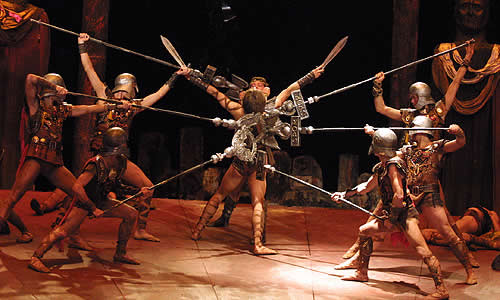
Then during shows, possibly held in the evening, gladiators would engage in realistically choreographed mock battles, accompanied by historical readings about gladiatorial matches from the works of Latin poets such as Seneca, Broccoli said.
Gay pundits are already wondering whether the "choreographed battles" will take their cue from the Kirov Ballet's famed choreography for Khachaturyan's "Spartacus" ballet version of the slave revolt in 71 BCE which was led by disgruntled gladiators.
With issues of historical accuracy, art, taste and national pride at stake, Sr. Broccoli was asked if the planned shows might be considered vulgar, to which he retorted: "The gladiators themselves were vulgar, they were sweaty, they stank and they swore. Why not show them as they were, for real?"
While saying that he wanted to avoid "tasteless kitsch", Broccoli warned that Rome's museums and monuments can no longer afford to be "collections of antiquities, often badly exhibited and explained". It is important to revive the age of the gladiators "as it really was", said Mr. Broccoli.
The aim is to recreate the authentic sights and sounds of a gladiatorial contest. "Only in this way can one succeed in making a visit an experience that won't be forgotten," he said.
The real-life gladiators will not be just the out-of-work actors who pose for snapshots with tourists with the Colosseum as a backdrop. Broccoli said these would be men who have been trained at a nearby gladiatorial school.
Sergio Iacomoni, who has run the gladiator school in Rome since 1994, said: "We have 200 students and are more than willing to take part in this. This is a real passion for us."

The fighting gladiators proposal is only the latest scheme which officials in Rome have come up with in recent months. Last summer they unveiled plans for an "Ancient Rome Theme Park" which would cater to families for whom the real actual artefacts of Ancient Rome are not exciting enough.
This year is proving a "black year" for tourism in Rome with tourist numbers down five per cent, and the global economic meltdown has spawned fears are that thousands of waiters, cooks and hotel staff will have to be laid off.
The city's new deputy mayor, Mauro Cutrufo, says that what the Eternal City really needs to keep visitors coming is not museums, but fun rides so as to attract car-loads of families, not just individual tourists. "The model is EuroDisney in Paris," said Cutrufo, as he announced plans for a 500-hectare (1,250-acre) theme park on the outskirts of Rome, which could be ready in three years, he said.
If Cutrufo gets his way, anyone bored of touring actual remains of republican and imperial Rome can head to the suburbs to see the same thing in fiberglass.
Instead of "Pirates of the Caribbean", visitors would be offered rides through a replica of the Colosseum, where they could watch gladiators fighting each other or wild animals, as the Emperor looked on.
Cutrufo has also suggested putting cloth-covered panels in the gaps of the facade of the Colosseum to give visitors an impression of how the arena looked when it was built.
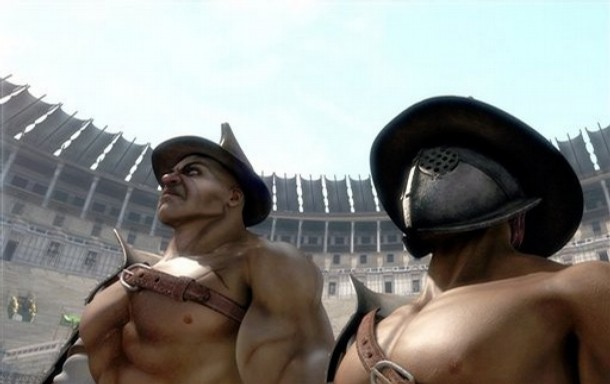
Just four weeks ago a new sort of Imax-style multi-media show called "Rewind Rome" opened in Rome. It is a 3-D simulation which will be shown to ticket-buying tourists in a theater a few steps from the Colosseum.
Virtual tourists see the simulation on a giant screen and animated characters guide them through the streets of Rome as they appeared in A.D. 310, during the reign of the Emperor Maxentius.
The show features a virtual tour guide clad in a toga and named Sapientus, which is Latin for "Wise Man". He takes the viewers on a virtual tour of his ancient hometown and gives them a running commentary which at times makes him come off sounding less like a "Wise Man" and more like a "Wise Guy".
For example, Sapientus tells viewers there is a financial crisis which has swept Rome, wiping out people's fortunes. Some greedy Patricians who had speculated on bad loans given by unscrupulous bankers ended up having to fall on their sword or open a vein, says Sapientus.
"Oh no! My life savings! I could have earned more by keeping my money under the mattress!" Sapientus tells the viewers -- who may be wishing they had done the same thing rather than spending money on a trip to Italy during a global recession.
But the most dramatic effects are in gladiatorial scenes in the Colosseum. The audience (wearing 3-dimensional glasses) leaps back in shock when evil gladiator Bestia shoves his sword at them. Then visitors board a high-tech version of the pulley-system elevators that existed under the floor of the arena and glimpse a tiger and a hunter locked in combat overhead.

Critics to all of these tourist-draw plans say that the tax money would be much better spent on maintaining and upgrading Rome's museums and monuments.
Earlier this year, experts warned that security is so lax at most sites that tourists are "stripping Rome bare" of its antiquities. Archaeologists said that Trajan's Forum, in the heart of the city's classical ruins, had been stripped of all the fragments of statues and shards of amphorae that had adorned the site until recently. To highlight the problem, a reporter from Il Messaggero newspaper carried away large boxes full of ancient artefacts during the daytime without being challenged.
The newspaper blamed the 20 million tourists who pass through the city each year for the looting. "Who knows how many of these small fragments now adorn living rooms all over the world?" it said.
An archaeologist working at the site said: "Everything has been taken from Trajan's Forum. The close-circuit television cameras are pointless, and the gates are practically non-existent. Even a child could climb over them.
"The treasures of ancient Rome are very vulnerable, but there are lots of gaps in the security system of one of the most important archaeological areas in the world." He added that he had often seen people in restricted areas, collecting keepsakes.
And for armchair tourists who cannot afford to travel to Rome so as to loot it personally, Google Earth has launched a 3-D reconstruction of ancient Rome as it looked in 320 AD. The virtual traveller can now see some 6,000 structures -- including the Colosseum -- in loving detail as they looked in Rome in the early 4th Century. In reality, just 300 buildings of classical Rome have survived, of course, in most cases only as ruins.
OR HOW ANTINOUS SURVIVED THE FALL OF THE THIRD REICH
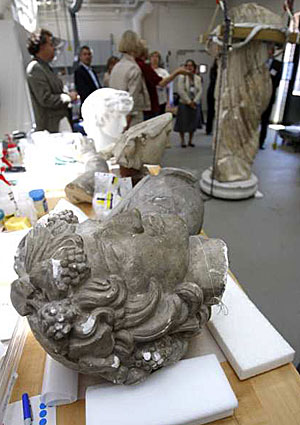
The elusive and mystery-shrouded statue known as the "Getty Antinous" has at last been unveiled to the public and will be on view at the J. Paul Getty Museum at the Getty Villa in Malibu, California, in a splendid new exhibition which runs December 18th, 2008, to June 1st, 2009.
But those of you who are looking for an answer the the riddle surrounding the identity of this statue will be disappointed -- the Getty Villa experts are as mystified as ever as to whether this statue is indeed an image of The Beloved Boy.
The exhibition, entitled "Reconstructing Identity: The Statue of a God from Dresden", offers a marvelous behind-the-scenes look at the investigative, forensic-like skills of museum conservationists as they attempt to strip away layers of botched and misleading "restoration" work from previous centuries in order to determine precisely who and what an ancient statue is supposed to represent -- or even whether a supposedly "ancient" statue is really ancient at all.
The story behind the Getty Antinous is a story of mystery and intrigue, of skullduggery and deception, of Nazi terrors and Cold War brinksmanship.
It all started sometime during the 17th Century AD when a monumental statue of a god was found in Italy. What was preserved of the original work was an imposing male figure, half-draped to reveal a masterfully carved torso. The arms, the head, and parts of the drapery were missing.
In keeping with the tastes of collectors at that time, the sculpture was restored to completeness with additional pieces of carved marble, including an ancient head from another work — creating a pastiche of ancient and modern stone that confused the original identity of the statue.
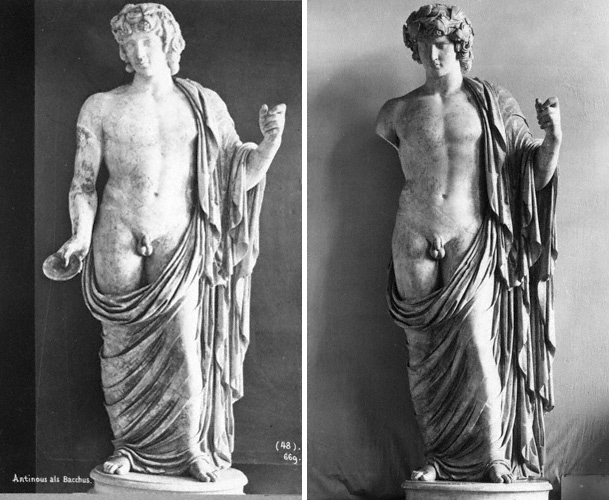
Over the next two centuries, the restorations were reinterpreted, removed, and replaced, and the figure assumed a variety of heads and identities including Alexander the Great, Dionysus/Bacchus the wine god, and the Great and Good Boy God Antinous in the guise of Dionysus/Bacchus.
The "Reconstructing Identity" exhibition explores the statue's rich restoration history and the roles that aesthetics, archaeology, and art history have played as the understanding of the statue has evolved over the centuries.
"Even in the 19th Century it was recognized that early restorations were sometimes incorrect and misleading, perhaps none more so than this statue," Karol Wight, senior curator of antiquities at the J. Paul Getty Museum, told the online art newspaper artdaily.org.
"The difficult, though intriguing, question for us and our colleagues in Dresden is which of its past identities, if any, should the statue now assume?" she said.
Jens Daehner, the German-born assistant curator of antiquities at the Getty, told a colloquium at the museum last June that the statue was first displayed in Rome in 1704, when it carried an ancient female head (not original to it), probably a likeness of Athena but restored with a helmet so as to match an image of Alexander the Great seen on Greek coins. Though this sounds dreadful by today's standards of archaeology, during the Baroque era it was considered not only acceptable but indeed essential for fragmentary sculptures to be "restored" to wholeness.
After the statue was removed from Italy in 1733 by a Saxon prince and taken to Dresden, it was modified again to include a fig leaf and a spear, still identified as Alexander.
Then in 1804, according to a contemporary catalog of the museum's collection, it became Dionysus/Bacchus, a result of prevailing notions about its body type and drapery style, but retained the previous head and helmet associated with Alexander -- while losing the earlier restored right arm along with the fig leaf and spear.
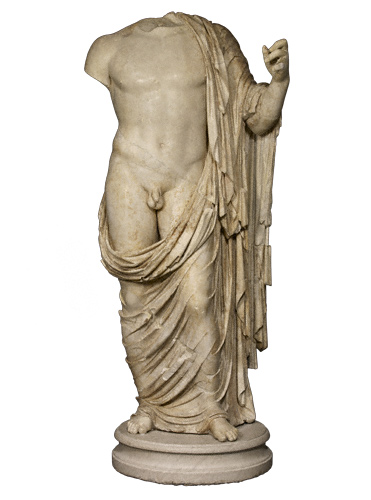
In yet another twist by a "restorer" for the Dresden antiquities collection, the statue became "Antinous in the guise of Bacchus", with a new head made of plaster and a new plaster right arm attached.
Then, in 1894, a new director of the museum replaced that "Antinous" head with a plaster cast of another Antinous on display in the British Museum. The right arm was again removed.
And this was the state of the statue when it was placed in storage during the Dresden museum's closure due to World War II. Miraculously, it was not damaged during the Allied Bombing of Dresden in February 1945 which reduced the entire city overnight to smouldering rubble and killed tens of thousands of civilians. But in June 1945 it was shipped to Moscow along with the rest of the collection, regarded as the spoils of war.
By the time it was returned to Dresden by train in 1958, the statue had suffered extensive damage in transit and had broken into 158 pieces. It remained out of sight, stored in four wooden crates until those crates were air-freighted to the Getty a couple of years ago.
Daehner was quoted by the Los Angeles Times recently as saying the statue's "high, wide chest" leads him to think it is indeed Antinous. But other experts at the week-long Getty Museum colloquium last summer were unable to agree 100 per cent on identifying the statue. The only thing they could agree upon is the fact -- based on microscopic analysis of the marble -- that the statue is indeed 1,800 years old. So at least we know it is not a more modern replica.
The curators finally decided to place the statue on display at the Getty Villa on December 18th without a head or any of the earlier restorations of arms or accessories. However, those heads and the missing arm are also on view as part of the exhibition.
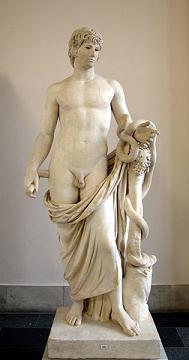
Actually, it was common in ancient times for heads to be joined to pre-sculpted bodies. If you wanted a statue of your dear lame old uncle Claudius looking like Mars, you would go to a sculptor's studio and pick out a fine generic Mars statue -- without a head. Then the sculptor would fashion a head with the facial features of your uncle Claudius to be cemented onto the statue and -- voila -- you would have your Mars-Claudius.
This was also done with statues of Antinous. The famed Berlin Antinous Agathodaimon statue (pictured at left) is a good example. The head of Antinous was grafted onto a Dionysus-Agathodaimon (Dionysus Blessed Spirit).
So the question that the experts always face, of course, is WHEN was the head grafted onto the body? Was it grafted onto the body in ancient times by the original sculptor, perhaps on orders from the emperor himself? Or was it done in more modern times by some rich collector who had various bits and pieces of statues and who asked a sculptor to do a "Dr. Frankenstein" job of glueing the bits and pieces together?
And THAT is at the heart of the real mystery surrounding the Getty Antinous. Did Hadrian commission the statue to underscore his Dionysiac Hellenism? Or did Baroque and Victorian "experts" put the head and the body together just so they would look "nice"?
But the spiritual mystery is whether the statue has in fact become "in-dwelled" by the divine spirit of Antinous either in ancient times or over the course of the centuries.
The Ancient Priests of Antinous had the ability to SEE the divine spirit inside a block of stone and to know that it was Antinous. What the early Christians called soulless "idols" were in fact alive with spiritual energy to the Ancient Priests of Antinous.
Most people have lost the ability to SEE the divine in inanimate objects or, for that matter, in other human beings -- or in themselves. But a few people today still have the ability to SEE beyond the exterior to discern the spirit within.
Our modern rationality society tells us that there is nothing sentient beyond ourselves. We humans are alone in an unthinking and unfeeling universe. Oh, some animals display a bit of intelligence. But we are basically alone. It is the Judeo-Christian idea that God is "out there" and that all images are empty idols. Cold stone bereft of anything but mineral molecules.
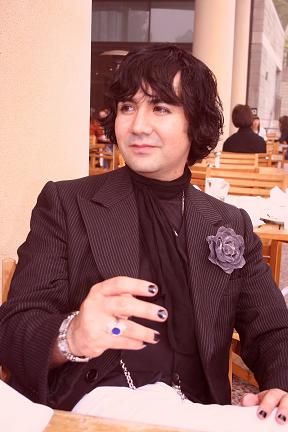
Arch Priest Antonyus Subia discussed this point during a recent pilgrimage to the Getty Villa in Malibu (photo at right taken at the Getty Villa). He noted that even many pagans fall into this mind trap and think of their deity as being "out there" somewhere and not in-dwelling in the little statuette in the house altar. It's just a sacred symbol. But it is not in and of itself special.
The Ancient Priests of Antinous would disagree with that, as does Antonyus Subia. An image of Antinous is in and of itself special. The LUMEN ANTINOI (Light of Antinous) shines through its eyes. It is for us to SEE the divine within the image.
The statues of Antinous were not "idols" because the Ancient Priests of Antinous could never have conceived of such a notion. It is important that we remember that the Ancient Priests of Antinous conceived of a world which was -- unlike our own -- an ANIMATED world from the beginning. Everything in their physical world was alive with spiritual dimensions.
They didn't PROJECT a spiritual entity into a hunk of carved marble. Instead, they APPREHENDED the spiritual entity that was already inside the stone.
Anybody who has been around Arch Priest Antonyus Subia has seen him use his Inner Eye to do the same thing. He will look at a statue of a "Greek Ephebe" and will look inward for a moment and then will say, "It's Antinous!" Some have criticized him for doing this, saying he can't possibly know the provenance of the statue and whether it was perhaps actually supposed to be Hermes or someone else. Antonyus uses his Inner Eye and "sees" the spiritual Blessed Boy in the stone -- or says it is not Antinous, as the case may be.
Arch Priest Antonyus and Priest Uendi and Knight Stephanos, founding members of the Hollywood Temple of Antinous, are making their own pilgrimage to the Getty Villa in Malibu to cast their Inner Eyes on the Getty Antinous now on exhibit there, and then we will know a bit better whether this wayward, piecemeal statue is in fact an in-dwelled Sacred Image of The Beauteous Boy.
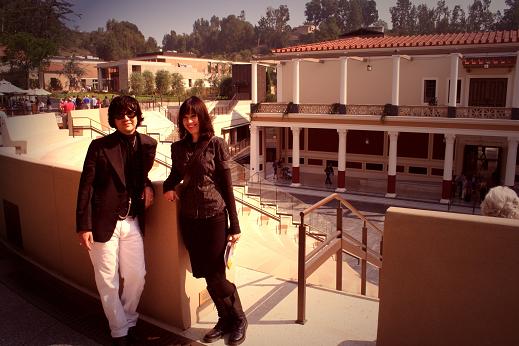
The Ancient Priests of Antinous were deeply aware of the interdependence between the Divine World and the Human World. In the times in which they lived, these two spheres were not experienced as separate from each other in the way that they have come to be experienced today.
It is our goal in this distant, soulless, post-modern age, to rediscover this ability to live in relationship to, and act as a conduit for, Antinous the Gay God.
We cannot recreate the Ancient Religion of Antinous. It is dead and we human beings have developed in other directions. There is no point in dressing up in togas and role-playing at 2nd Century rituals bereft of meaning for 21st Century gay men -- lest we become as laughable as fundamentalist Christians who argue endlessly over literal interpretations of scripture. No, we are not attempting to "reconstruct" the Religion of Antinous. Our goal is to fashion a New Religion of Antinous which meets the spiritual needs of post-modern, post-Christian and post-pagan gay men.
But we can learn from the Ancient Priests of Antinous. The cosmos of which they were aware was primarily spiritual and only secondarily material. In their physical world, everything was spiritually alive -- even generic statues with glued-on heads. The main task of the Ancient Priests of Antinous was to build a magical bridge between physical and spiritual reality, momentarily bringing them into conjunction.
Indeed, that is the one true spiritual goal any human being ever faces. And it is the greatest mystery of all.
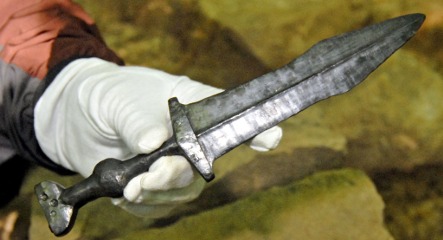
Archaeologists have discovered an ancient battlefield in Germany which indicates the Roman Legions were still fighting Germanic tribes deep inside "barbarian" territory as late as the 3rd Century AD -- 200 years later than hitherto believed.
The find of some 600 artefacts strewn over a radius of a 1.6 kms (one mile) indicates a skirmish must have occurred between Germanic tribesmen and Roman soldiers around the year 200 AD. Finds include hundreds of speer and arrow points, catapult projectiles, metal fittings for Roman supply carts, hand weapons, plus insignia and braiding from uniforms and breastplates, according to Petra Loenne, chief archaeoligist at the dig site. The site is located in woods outside Northeim, a town about mid-way between Kassel and Hannover in north-central Germany.
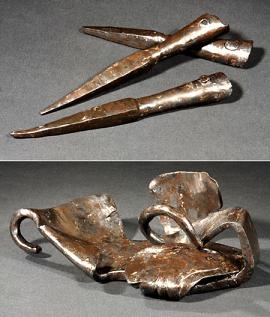
Loenne says the clincher was the discovery of Roman coins bearing the image of the Emperor Commodus, who ruled from 180 to 192 AD.
Other artefacts ranged from Roman sandal nails to arrowheads and 15-centimeter-long iron spear points that once capped javelins fired from giant crossbows called ballistae. At least one arrowhead still contained enough of the original wooden shaft to provide organic material for radiocarbon dating, which placed the arrow to some time between 200 and 250 AD.
Loenne immediately recognized an unusual tangle of metal. Called a "hippo-sandal," it was a sort of early horseshoe that was wrapped around the hoof of a horse or draft animal (see picture). "It definitely wasn't medieval," she says. In fact, it was Roman -- an oddity because Lower Saxony, where the artifact was found, is hundreds of kilometers north of the known Roman frontier.
The dig site is 160 kms (100 miles) east of the Teutoburg Forest -- 160 kms too far east and two centuries too late, as far as the history books are concerned.
The discovery comes as preparations are being made to commemorate the 2,000th anniversary in September 2009 of the famous Battle of Teutoburg Forest in which three elite Roman Legions -- the XVIIth, XVIIIth and XIXth -- were utterly annihilated by Germanic guerrilla fighters in September of the year 9 AD.
The defeat of the crack troops, who were led to their deaths by ex-Consul Publius Quinctilius Varus, effectively changed the course of Western Civilization.
Prior to 9 AD, Emperor Augustus Caesar pursued a course of military expansion across the Rhine and into central and northern Europe. After 9 AD, the Rhine became the frontier between the "civilized" Roman world and the "barbaric" lands to the east and north. Prior to becoming emperor, Hadrian himself had served a stint of duty along the Rhine. As emperor, he consolidated the borders of the empire and his forces never ventured across the Rhine into across-the-Rhine Germania -- or so it has always been believed.
The new discovery indicates that the Romans continued to maintain troops east of the Rhine.
Historians have always referred to the Battle of Teutoburg Forest as a defining moment which affected the course of history. It has even been cited as a factor in both world wars, especially by the French and British, who considered themselves to have a Roman heritage, as opposed to the Germans, whom war propagandists condemned as the descendants of barbarians.

In fact, the leader of the Germanic tribal forces was a tribal chieftain named Arminius, who had been educated in Rome and had become a trusted friend of Varus. The idea was that raising future chieftains in Rome would bond them to Rome when they returned to their families on the frontier.
Arminius was an example of how that policy could backfire and result in knowledge of Roman ways being used against the Romans. Arminius ingratiated himself with Varus, who was one of the most influential men in Rome, a friend of Augustus Caesar himself. It was that trust in Arminius which resulted in Varus leading a punitive expedition into an indefensible, boggy forest without sentries or reinforcements -- on advice of his trusted friend Arminius.
In the resulting massacre, Roman soldiers fled for their lives. Most were cut down in the mud. Blue markings in the graphic at right show where Roman bodies and armament have been found. Those who survived were sold into slavery or else were placed in wicker cages and burned alive as sacrifices to the Germanic deities. Reports of the battle are sketchy for the simple reason that almost no one survived to report what had happened.
Never before had three entire legions been wiped out in a single battle. The defeat was so devastating that the numbers of the Legions XVII, XVIII and XIX were retired forever, never again to appear in the Roman Army's order of battle. Augustus was so traumatized by the loss of three elite legions that he went into a prolonged state of mourning as though for a beloved son -- he tore his clothes, refused to cut his hair for months and, for years afterwards, was heard to moan from time to time, "Quintilie Vare, legiones redde!" ("Quinctilius Varus, give me back my Legions!").
This scene from the epic BBC/PBS mini-series "I, Claudius" dramatically recreates how Augustus received the news:
As a result, Germany was never incorporated into the Roman Empire, leaving that region a breeding ground for barbarian incursions which eventually would bring down the empire and eventually (according to Allied war-time propaganda) result in two world wars.
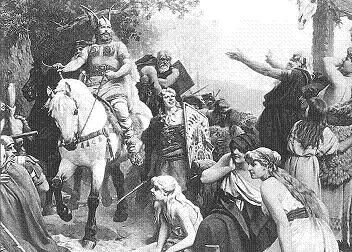
Arminius, known as Herrmann to the Germans, has indeed come down through German history as a heroic symbol of liberty and German national strength. Herrmann turned back the Roman occupation forces forever, according to the popular interpretation by German nationalists. In the late 19th and early 20th Century, unscrupulous German leaders used Hermann as a rallying figure in wars of aggression.

A monument near the site of the Teutoburg Forest battlefield celebrates Herrmann as a national hero. Thousands of German tourists visit the site annually. And the regional soccer team (in Bielefeld) is called Bielefeld Arminia. "Armin" is a popular name for German boys to this day.
Archaeologists in recent years have determined the exact location of the battle near the modern village of Engter north of the city of Osnabrueck. Bones, weapons and armour from the fleeing soldiers of the XVII, XVIII and XIX Legions are strewn along a narrow 17-km-long stretch of marshy woodlands bounded by confining hills to the north and south.
But the new archaeological discovery, if verified, could mean that the history books must be rewritten. That is because the newly discovered 3rd Century battlefield is located 100 miles (160 kilometres) further east of the Teutoburg Forest.
"The find can be dated to the 3rd Century and will definitely change the historical perception of that time," according to Dr. Henning Hassmann, director of historic preservation in the state of Lower Saxony.
So far, 600 artefacts have been unearthed, clearly documenting their Roman 3rd Century origin and dating, says Michael Wickmann, an official in the town of Northeim, where the dig has been conducted over a period of months. The dig location has been kept under wraps to prevent the site being overrun by curiosity-seekers and looters.
The location so deep within the territory of the Germanic tribes is a mystery to archaeologists.
"It is pretty normal to find evidence of Roman culture all over even up in Scotland, but a find like this in northern Germany is really amazing," Wickmann told reporters in announcing the find. "And it's spectacularly well preserved."
Initial reports said that DNA fingerprinting evidence indicated that some of the arrows had been made of African wood, which was the preferred wood used in manufacture of Roman arrows. But Hassmann said he could not confirm those reports.
The latest discovery came as archaeologists continued to dig at the site of what appears to have been a Roman military outpost nearby. It is unknown whether that outpost pre-dates the 9 AD Battle of Tuetoburg Forest or whether it might be a later tribal camp where Germanic warriors stocked up on Roman-made armaments smuggled or looted from imperial frontier garrisons.
If it turns out the Romans did in fact persist in making incursions into across-the-Rhine Germania, then a lot of historians will have to rewrite a lot of history books. Those historians will feel like proud Quinctilius Varus, who fell on his sword as his world of complacency and comfort died in the screams of the men around him. The historians will remember Varus whispering in despair and disbelief: "Ne cras! Ne cras!" (Not the same as yesterday!)
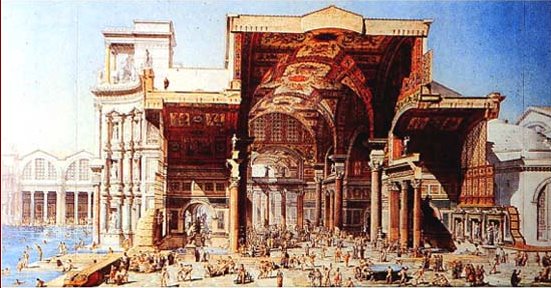
A majestic hall at Rome's Diocletian Baths opened its doors this week, after 30 years of restoration work at one of antiquity's most elaborate and spectacular public baths complexes -- a veritable cultural entertainment and recreation center.
The 40-metre-long and 25-metre-high "Aula X" (Hall 10), with soaring vaulted ceilings, is one of a series of such halls -- the other nine are still not accessible to visitors -- that form part of the Baths first inaugurated by the Roman Emperor Diocletian in 298 AD and finished in 306 AD.
Over the centuries, several Roman emperors continued to expand the baths complex or Thermae from which Rome's nearby Termini railway station derives its name.
Hall 10 of the Baths today houses part of the Museo Nazionale Romano (National Roman Museum), while its huge frigidarium, a pool area once used by patrons to cool down after a steam bath, was converted in the 16th Century into a Christian church, the Basilica of Santa Maria degli Angeli e Martiri -- which was designed in part by Michelangelo Buonarroti, who is of course a Saint of Antinous.
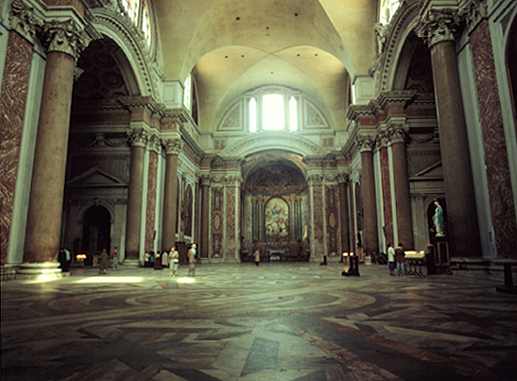
Dedicated in AD 306, the Baths of Diocletian (Thermae Diocletiani) were the largest and most sumptuous of the imperial baths and remained in use until the aqueducts that fed them were cut by the Goths in AD 537.
Similar in size and plan to those of Caracalla, they are so well preserved because various parts later were converted to ecclesiastical or other use.
Almost a century after Caracalla gave Romans his gargantuan Baths, Emperor Diocletian, who never even visited Rome, strove to outshine his imperial predecessor by commissioning the largest and most gorgeous bathing establishment the world had ever seen.
It could accommodate 3,000 bathers simultaneously, about twice as many as the Baths of Caracalla, covered 13 hectares (32 acres) and had the full panoply of changing rooms, gymnasiums, libraries, meeting rooms, theaters, concert halls, sculpture gardens, vast basins for hot, lukewarm and cold plunges, as well as mosaic floors and marble facades.
Today's luxurious spas and health resorts are but pale copies of the Baths of Diocletian.
The three soaring vaults of the church transept provide, as does The Divine Hadrian's Pantheon, one of the few glimpses of what the original splendor of life in Imperial Rome must have been like.

The long-lost Colossus of Rhodes is to be rebuilt as a "sculpture of light".
The ancient monument, which straddled Rhodes town harbour and stood 34 meters high (over 100 feet high), was toppled by an earthquake in 226 BC.
But there are now plans to recreate the legendary statue with the help of German artist Gert Hof, the British newspaper The Guardian reports.
"It will be a unique architectural creation," said the island's mayor, Hatzis Hatziefthimiou.
"We want to make it a work of global appeal and significance."
The new Colossus will stand on outer pier in the harbor area of Rhodes, and be visible to passing ships, the paper said.
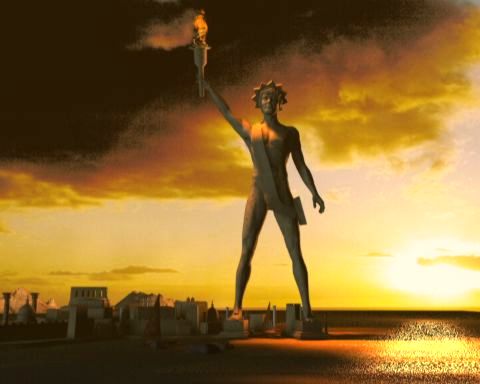
Built in part from melted down weapons, the new sculpture will be dedicated to celebrating peace.
It will also be bigger than the original, and will use light to "tell" a variety of stories.
"We are talking about a highly, highly innovative light sculpture, one that will stand between 60 and 100 metres tall so that people can physically enter it," Dr Dimitris Koutoulas, who is heading the project in Greece, told the paper.
"Although we are still at the drawing board stage, Gert Hof's plan is to make it the world's largest light installation, a structure that has never before been seen in any place of the world."
The statue is also expected to cost up to 250 million US dollars, reports said.
Carved by Chares of Lindon, one of antiquity's greatest sculptors, the original Colossus of Rhodes was erected in homage to the Sun god Apollo-Helios. It is believed to have been about 120 feet high on a 25 foot white marble plinth (compared with the Statue of Liberty's 151 feet on a 159 foot plinth).
For almost seven decades it stood over Rhodes before being destroyed by an earthquake in 226 BCE.
In later years, its huge bronze and marble parts were carted off by Arab tradesmen. "Even lying on the ground, it is a marvel," wrote Pliny the Elder. It was so big, he said, that "few people can get their arms around its thumb".
Although historians have spent years arguing about the wonder's exact location, artists have always depicted it straddling Rhodes' imposing harbor.

Unlike the original statue, which took Chares 12 years to carve in situ, the new statue could be built in less than half that time if adequate funding is found, project organisers say. While the Statue of Liberty was built in France and then assembled in New York, the new Colossus is expected to be built by locals on the island.
The Colossus was included in Sidon's List of the Seven Wonders of the World compiled some 2,137 years ago along with The Pyramids, the Walls and Hanging Gardens of Babylon, the Temple of Artemis at Ephesus in modern Turkey, the Statue of Zeus at Olympia, the Mausoleum at Halicarnassus and the Lighthouse at Alexandria.
Antinous and Apollo were equated with each other by the Ancient Priests of Antinous. Arch Priest Antonyus Subia describes Antinous-Apollo as Guardian of Civilization:
"Antinous-Apollo is more deeply concerned with the welfare of mankind. One finds the socially conscious aspect of this religion, the ways in which it can be used to highten the consciousness of society. Those who seek to benefit our world with the wisdom and grace that the muses inspire follow this face of Antinous whose statue has always stood in the sanctuary of Delphi on the slope of Mount Parnassus. Antinous speaks through visions, dreams and the understanding of oracles. One who loves this god seeks after wisdom and learning, and after the enlightenment of all that is veiled in darkness and ignorance."